














Lies have become distressingly prevalent, infiltrating the fabric of our society and straining the bonds of trust. I’m not sure if it is worse now than 10, 20, or 30 years ago, but it sure feels like it. It’s too easy to blame Donald Trump, but he is probably the biggest offender. Yet he is running again for POTUS and, at this point in time, a large number of Americans appear willing to forgive his sins and vote for him again. Politics aside, are we really willing to elect a president who lied repeatedly, was convicted (and has pending possible convictions) on multiple charges, incited violence in our Capitol, and panders to the most extreme people in our society? What are we teaching our kids about lying? Are we teaching them that it’s okay, and the better you are at it, the more successful you will become?
As an avid news consumer, I admit that it is difficult to know who is reporting the facts and who is perpetuating their agendas. Most days I read multiple sources to triangulate what is really going on. Half the time, I can’t tell.
I know I have lied in my life and I’m not proud of it. Although they were mostly white lies or half-truths, they weren’t the whole truth. Is this human nature or is it a learned response? I don’t know, but it is troubling. While some argue that white lies or lies of omission can be harmless or even beneficial in certain situations, a closer examination reveals the inherent immorality of any form of lying. The fundamental premise lies in the violation of trust and the negation of an individual’s autonomy to make informed decisions based on accurate information.
Lying erodes the interpersonal relationships upon which societies are built. Honesty is the foundation of trust, and without trust, the bonds between individuals weaken. Lying creates a climate of suspicion and erodes the ability to rely on others. The deceived individuals suffer emotional distress and experience a breach of trust that can be difficult to repair. In the long term, chronic lying damages one’s reputation, further isolating them from others and undermining their credibility.
Society functions on trust and cooperation. Lying corrodes these vital elements. When lies permeate the social fabric, they engender a culture of deceit, breed cynicism and undermine social cohesion. Trust is essential for meaningful relationships, business transactions, governance, and the functioning of institutions. By eroding trust, lying weakens social institutions, impairs cooperation, and obstructs progress. In contrast, a commitment to honesty fosters transparency, accountability, and mutual respect, paving the way for healthier societies.
Ethical theories offer insight into the immorality of lying. From a deontological standpoint, lying is inherently wrong, as it violates moral principles such as honesty, respect for others, and the duty to uphold truth. Immanuel Kant famously argued that lying is impermissible, even in extreme circumstances, as it treats others merely as means to an end rather than as autonomous beings deserving of respect. Utilitarianism also condemns lying, as the consequences of deception often lead to greater harm than good. Virtue ethics emphasizes the cultivation of honesty as a virtue, guiding individuals to embody truthfulness in their actions and relationships.
Lying to oneself is also a deceptive act that we often engage in, perhaps unintentionally, as a means to shield ourselves from uncomfortable truths or to preserve a preferred self-image. It is a subtle dance between our conscious and subconscious, where we craft intricate narratives and convince ourselves of their validity — even in the face of contradicting evidence. This self-deception can manifest in various forms, such as denying our flaws, downplaying our mistakes, or ignoring the consequences of our actions.
Lying to oneself can provide temporary solace, creating an illusion of control and avoiding the discomfort that truth might bring. It is a defense mechanism, a way to protect our fragile egos and maintain a sense of stability. However, in the long run, it hampers personal growth and inhibits genuine self-reflection. By constructing these elaborate facades, we deceive not only others but also ourselves, hindering our ability to understand our true motivations, desires, and vulnerabilities.
So next time our leaders, colleagues, business associates, family members, or we lie to ourselves, call them — or ourselves — out. Don’t brush it under the rug because he/she represents your party, business interests, or family harmony. If need be, make a point of condemning the lies. I remember lying as a child and disappointing my parents. It felt as terrible to me as it did to them. But clearly, many people have compromised their consciences and have no problem lying…a lot. We can’t accept this behavior and it’s time we start doing something about it.
Let me know how you feel.
Craig M. Kaminer, Publisher craig@slmag.net

PUBLISHER
Craig Kaminer craig@slmag.net
EDITOR IN CHIEF
Christy Marshall EditorSTL@slmag.net
DIGITAL CONTENT EDITOR
Grayling Holmes DigitalSTL@slmag.net
ADVERTISING
Cortney Vaughn Cortney@slmag.net
Rachel Sokolich Rachel@slmag.net
Karen Palmer Bland Karen.palmer.bland@gmail.com
CONTRIBUTORS
Writers
Grayling Holmes
Design
Stephanie Grateke
Photography
Suzy Gorman
Alise O’Brien
Carmen Troesser
SOPHISTICATED LIVING MEDIA
Eric Williams
Bridget Williams
Greg Butrum
Jason Yann













Inspired by her time living in London, the homeowner of this Clayton condo wanted to create a space that was modern yet classic with an English design influence. She called on designer Meghan Heeter with Castle Design to bring her vision to life.



The catalyst for the design was the black lacquer finish that appears throughout the condo. In the newly expanded kitchen, the black lacquer finish gives presence to a large and central island topped with gray quartzite countertops and decked with blue leather Jessica Charles counter stools. Blue notes appear throughout the condo as the sophisticated black-and-white color palette is mixed with blue and white touches. The curvilinear dining chairs from Century soften the space in the dining area adjacent the kitchen.
Classic yet contemporary, this kitchen celebrates the beauty of English elegance.
fulfill environments for today’s lifestyles.
Not so long ago, chefs competed for attention and patrons. Of course, they still do. But now more chefs are collaborating, working side by side, learning from each other, creating additional buzz in the food community, and filling more seats in their restaurants. Perfect example: when Jacob Siwak joined Craig Rivard for a threeday chef collaboration in St. Louis. It immediately sold out.

Jacob Siwak grew up in St. Louis, graduated from John Burroughs School, Washington U. and then the International Culinary Center in New York City. In 2020, he opened Forsythia, a critically acclaimed Roman (aka authentically Italian) restaurant. Craig Rivard graduated from the Culinary Institute of America and worked in New York City at such restaurants as Gotham Bar and Grill, Marlow & Sons, Clover Club, and Lani Kai. In 2019, Craig and his wife, Mowgli, moved home to St. Louis to open Little Fox.
“The last time I came home to St. Louis to see my family, I told my parents that there were a number of new restaurants in St. Louis that I wanted to try,” Jacob says. “Little Fox was at the top of the list. I knew from the second I got to Little Fox that Chef Craig had spent time in New York working at some of the top restaurants there. It was immediately apparent.” The telltale signs including the chef’s immaculate coat and apron with all the necessary pens tucked into his sleeve, an organized open kitchen, “everything needed for plating
organized in a clean line, his line cooks were clean and organized and the whole team moved with intention.”
Jacob says that he sees more cooking with intention in New York than he does anywhere else. “If you’re not cooking with intention in New York, you’re not gonna make it,” he says. “People just won’t go to your restaurant. And Craig has spent time at some of my favorite restaurants in New York. So, I went up and introduced myself to him.”
Reflecting on his first meal at Little Fox, Jacob says the food was delicious. “It was nuanced and complex without being overwrought in that way. They call it modern neighborhood food, and that’s exactly what it is,” he says. “The ethos of [Craig’s] cooking is very much similar to the ethos of my cooking, even if it’s not Italian food. His whole mantra is simple food done well, which is exactly what my mantra is. So, it felt like a natural fit to me. Our menus are very alike. Even if one’s very Italian and one’s very much not, they still feel pretty similar to one another.”
Jacob and Craig started a conversation about a collaboration. Jacob wanted to see how St. Louis responded to his pasta and to food that’s not necessarily what they traditionally imagine as pasta. His cooking is closer to what you would eat in Rome (as in why his restaurant is in the Roman genre) and not very much like the American take on Italian food.
The New York City/St. Louis Culinary Connection
Simple food done really, really well
 Pasta Fagioli - hand-made cavatelli with cannellini beans, stewed tomato, kale, and breadcrumbs.
Pasta Fagioli - hand-made cavatelli with cannellini beans, stewed tomato, kale, and breadcrumbs.
“I love St. Louis, Jacob says. “I still view it as home even if I haven’t been here for 10 years. Craig’s from St. Louis and he feels passionately about St. Louis and, like me, he really wants to grow the food scene here.” Jacob recalls Craig vocalizing very explicitly that having other good restaurants pushes him to be better. So, cooking side-by-side made sense. Like their cooking, it was a collaboration with a large cup of intent.
One thing Jacob did not expect was that “there are people in St. Louis who really want to be in hospitality, especially at Little Fox. It is a pretty unique thing to have an entire team that isn’t just doing it as a gig and isn’t just doing it to make a little money while they do something else.” The benefits of the collaboration were as good for Jacob as it was for Little Fox. “I got great feedback from the Little Fox team who were excited for the chance to work with a New York City restaurant…even if it were just for a few days.
Chef Craig reflects, “Sometimes I think with certain staff a collaboration with another chef could feel like a burden or outside of their routine. But everyone at Little Fox was genuinely excited to work with Jacob. Our culture is as important as the recipes. Happy
cooks make better food. So, we spend a lot of energy on the culture at Little Fox and this collaboration was great for everyone.”

“I told Craig and Mowgli they have an unbelievable team,” Jacob says. “I said, ‘I don’t know how you assembled a group of people like this here, where finding hospitality talent is infinitely more difficult than New York.’ It’s exactly what we try and do in New York. We started by developing a culture that people really want to be a part of. We pay way above average. Our servers and our line cooks make more than they could possibly make at another restaurant. We offer actual benefits. We give real PTO [personal time off], which most restaurants don’t give. At Forsythia, you can take a day off and still get paid. You can take a week off and still get paid. And that’s unheard of. In New York, we offer health insurance benefits. When you work at Forsythia for a year, you get a largely free trip to Italy. We just offer benefits that companies outside of the hospitality industry offer. That makes a big difference.”
Jacob says that a lot of people think about it backwards in restaurants. They want to take care of the guests at all costs so that they can get good reviews, good feedback, and really positive
reinforcement from the guest. Second to that, they take care of their employees. When Jacob worked in Italy, he found the exact opposite frame of mind. He says, he “was told to forget about the guests for a second. Let’s pretend no one’s eating at this restaurant. Let’s all live happy lives where we all love what we’re doing and have a shared drive towards total excellence. First, let’s do that. And then it turns out that if everyone shares that mission and everyone is very excited to be at work and feels totally fulfilled by what they’re doing and enjoys what they’re doing in the moment that rubs off on the guest.”
It worked. “I saw firsthand that actually if you completely reverse it and you treat the people that work at the restaurant really well, they in turn will take care of the guests and give the guests a way better experience then trying to take care of the guests first,” Jacob says.
While he is not currently planning any new restaurants, Jacob says if he does, they would be a different concept than Forsythia. But if he opened outside of New York, it would likely be another Forsythia with a very similar ethos and menu.



The eternal question: Where does Jake like to eat in New York? “I eat at Lord’s a lot,” he says. “It’s an amazing British
restaurant known for its nose-to-tail cooking and extensive wine list. Owners Ed [Szymanski] and Patricia [Howard] also opened a restaurant called Dame, which is also phenomenal. They started it as little fish and chips pop up during Covid. Then they opened up Dame as a full seafood restaurant that immediately became the hardest table to get in New York. I think they’re gonna open another restaurant soon. I would say those are the two restaurants I’m most excited about right now.”
Growing up, my father had a lot of friends who were New York City cops. They knew where all the best cheap eats were, and I still remember all of those places which had great food but no atmosphere. Now I ask chefs where they like to go and some of my favorite restaurants are other chefs’ choices. I love sitting at the bar and often bump into chefs and restaurateurs, who are some of the world’s best critics and culinary conversationalists.
Jacob isn’t sure when he’ll be back in St. Louis, but when he is and if he is collaborating with another chef, I will be sure to let you know. Until then, go to Little Fox and next time you’re in New York, head straight to Forsythia. You won’t be disappointed. sl
Chef Craig Rivard of Little Fox manning the kitchen Nduja-marinated Newman Farm’s pork chop with grilled cabbage, bagna cauda, and polenta Prepared by Craig Rivard.

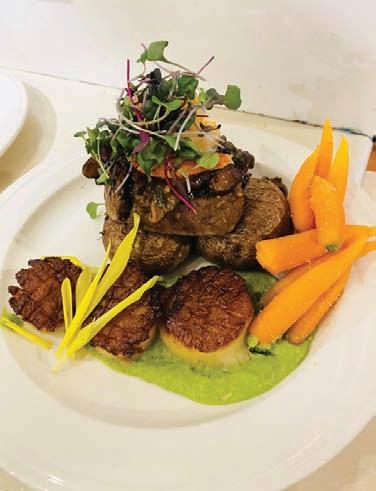
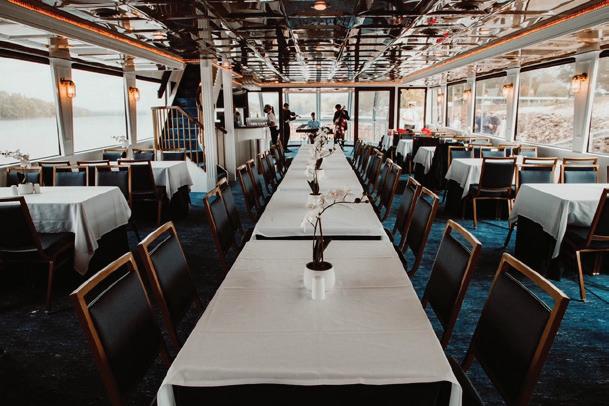



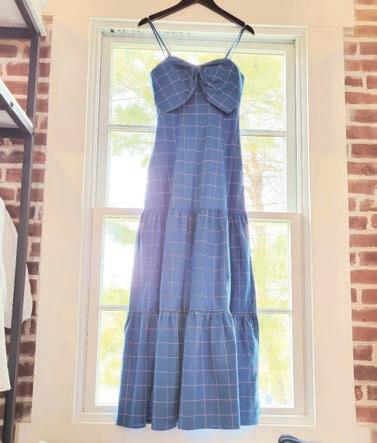











The allure of wine transcends geographical boundaries, offering a sensory journey that delights connoisseurs and casual enthusiasts alike. While regions like Bordeaux, Napa Valley, and Tuscany have long held the spotlight as the premier destinations to find fine wine, a new wave of emerging regions is making its mark on the global stage. As the world of wine continues to evolve, creating great wine destinations requires a harmonious combination of natural beauty, exceptional wines, and memorable experiences.
Many of these wineries take generations to create and evolve. Augusta, Missouri, founded in 1836 and designated by the Federal Government as the first American Viticulture Area, has produced wine for nearly 200 years but it’s never reached the status of Bordeaux, Napa Valley, or Tuscany. At least, it never has until now.
Augusta has had its historical highlights as when it saved the French Bordeaux crops from being destroyed in 1870 due to infestation. Only an hour outside St. Louis, the town has always been a great day trip, a pastoral place to go for a good meal and a bottle of wine. Over the years, Augusta also became a weekend getaway with a number of bed & breakfasts and wedding event spaces. Then in 2021, David and Jerri Hoffmann, natives of Washington, Mo., came to Augusta with a vision to build the area into The Napa Valley of the Midwest.
With the injection of more than $150-million in just 2 years, Augusta is growing and evolving quickly. While a small minority of its 263 residents don’t appreciate the growth or newfound commercialization, it’s hard not to be astounded by the Hoffmanns’ commitment to make Augusta a nationally recognized wine producing region and tourist destination— and not to be amazed at the speed at which they are doing it.
On the heels of acquiring four of the top wineries in Augusta – Mt. Pleasant, Augusta Winery, Balducci’s and Montelle, Hoffmann upgraded the production facilities and now employs more than 600 people. Like everything the Hoffmanns do with their hundreds of businesses around the country, they do it with steely determination.

Sophisticated Living first wrote about the Hoffmanns and their plans for Augusta in the Jan/Feb 2022 issue. Recently, I went back to check on their progress.
David, Jerri and I met at the White House Cafe with its impressive art collection mainly from the 17th and 18th century that was patterned after the design of the Ralph Lauren store in Chicago. There is an upscale women’s boutique next door, The August Clothing Co., that Jerri opened in April 2022; its traffic streams into the café, which serves breakfast, lunch and dinner.
Jerri is also opening a jewelry store later this summer; her family has been involved in the business for years. Terry Parish, who is opening up a home and garden center in downtown Augusta next to the White House Cafe, will oversee the future economic development of downtown Augusta. Across the street, the Hoffmanns recently bought Gallery Augusta, an art gallery and Amish furniture store. The shop specializes in handcrafted furniture and at any given time, has 50 desks on order from customers all over the country.
Underneath The Augusta Clothing Company, there is a nail salon. “The concept is you come over to these shops, get your nails done, have lunch, and then visit the wineries,” David says. “And it’s going exactly that way. You can see the foot traffic’s picking up weekly.”
David & Jerri Hoffmann walk the vineyardsThen below the nail salon, “We finished the buildout of the wine cellar that was covered in about 10 feet of mud” he says. ”Now it’s a place where you can dine or host events. And it’s probably the nicest wine cellar in Missouri. It’s called The Lost Cellar because after Prohibition it was filled with mud that we had to dig out. We’re putting in 125 French oak barrels so we can host parties and events there.”
The Hoffmanns plan to keep going—and growing. “We have finished the exterior modifications to the Hoffmann Hostel Hotel on Main Street, which we’re really excited to get open by September or October,” David says. “Sometimes it’s a lot more efficient from a cost point to rip it down and start over. But we never do that. We restore. So, some of these things are taking much longer than we anticipated because we had to rework the whole stone foundation. It only has 12 rooms for bicyclists to rent as a stopover on the Katy Trail and will cost around $60 a night. It’s a European concept and designed specifically for bikers.” The Hoffmanns also own a couple of bike shops so it’s now convenient to buy or rent bikes.
In neighboring Defiance, the Hoffmann’s purchased the Defiance Roadhouse, a popular biker (motorcycle) bar and the local bike shop. They also bought out the other restaurant and bar in town. The places are packed on the weekend. While the Roadhouse has historically been a beer bar, they are serving wine too, and making it part of the evolution of the entire area into a wine mecca.
The Hoffmanns also bought the airplane hangar and 12 acres next to the airport outside of Washington Regional. The hangar was redone making it the starting and ending spot for helicopter tours. There have been a couple of snags with air traffic control, but those should be worked out by Fall, according to David. “This should certainly make Augusta a destination as we can bring people to the area in a matter of minutes.”
In short, the Hoffmann’s strategy is to build a footprint of industry and commercialization whenever they go into an area. “When we first came, I think we had 30 people employed in the Franklin, Warren, and the St. Charles County area,” David says. “That number today is 600. We’ve bought companies, businesses, and I would tell you that this time next year, that number will probably be a thousand. It’s not all related directly to the wine industry. We bought a company called Noah Medical, which is a medical [bed] manufacturing company in Washington, Missouri. We bought Hillermann Nursery & Florist (now Hoffmann


Hillermann Nursery & Florist); we bought Town & Country Nursery; and we bought Ferguson Tree Farm and Nursery (now Hoffmann Ferguson Valley Nurseries).”
The Hoffmanns are under contract to purchase the Phoenix Center, a 600,000 square foot shopping center in nearby Washington. The deal was scheduled to close at the end of June. To support all of this growth and development, they also bought Ziglin Signs, because as David says, “We use a lot of signs.” They are vertically integrating every part of their business from the recent purchase of a 75,000 sq. ft. manufacturing plant to a bus and trolley company to bring people to and from the wineries. Last March, the company announced the purchase of JED Transportation of St. Louis, the largest motor coach company in the state of Missouri.
The acquisitions and developments are all centered around serving the wine industry and bringing people from St. Louis and beyond to Augusta. After the Hoffmanns announced plans for a 5-star resort-style hotel and golf course 18 months ago, they ran into some roadblocks. They changed architects mid-project and discovered that the championship golf course could not be excavated on the land they had staked out. Then they regrouped, hired a new architectural team, and changed the location of the hotel to accommodate an adjacent golf course.
The new hotel near Balducci’s Vineyards will have 110 rooms, a 225-acre golf course, spa, and pool. While David is tight lipped on the hotel brand—and name, he says it will be announced shortly and will be sure to impress. With Sunflower Hill Farm already established nearby for weddings and other large events, the new hotel will be perfectly situated to accommodate destination wedding weekends. “The other big thing that we did that I don’t think was in place last time we saw you, we put in the Miss Augusta [96-foot luxury yacht],” David says. “We finished the multimillion-dollar dock in Augusta and now the yacht is running out of Augusta for weddings, dinner cruises, and corporate retreats.”
The Hoffmann approach, David explains, is “We do this all over the country and we don’t cut corners. But we move quickly. “
Because of all the work and addition of people, “We’re moving our offices and we built new offices,” he says. “We’re going to lease space for a craft cocktail bar and cigar bar. It’s always encouraging when other businesses want to open up and be part of the excitement. For us, it’s all about selling the wine and getting the wine
The Augusta Clothing Companyon the map nationally and eventually globally. I think, two years into it, that vision and dream is going to happen. And we’re getting a great response on the quality of the wine, which has been enhanced.”
Some of the brands sell out pretty quickly. “We’re very, very pleased with how the wine is selling nationally,” David says. “We have great people that we have retained. We brought in others and we’ve staffed it significantly higher. We are planting 50 additional acres a year and it takes three years to get that yield, but that’s how confident we are in our sales process. We’re doing a joint venture with the University of Missouri. We’ve donated to them a couple acres for experimental and hybrid grape growing for new varieties in Missouri, which we’re really excited about.
“Our company and family donated a wine lab to a Florida Gulf Coast University to work with us on tastings, pairings, and the hospitality sector,” David continues. “It is very rewarding for me as a Missourian to be doing this in Missouri.”
Recently, the Hoffmann’s signed a 16-state distribution agreement with Breakthru Beverage (formerly Major Brands) to distribute wine in and outside Missouri. What they have always envisioned is more distributing wine outside of Missouri and putting Missouri wine on the map. “I think this time next year, there’ll be more wine distributed outside Missouri than there is in Missouri,” David says.
“One of our best red wines right now is our Cabernet Franc and the other is our Norton Reserve. Both those wines have been selected by some of the best wine restaurants in the state of Missouri. And I’ll start with Annie Gunn’s. Annie Gunn’s has our Cabernet Franc and our Norton Reserve on their wine list. And they’re a Wine Spectator 100 restaurant. The Cabernet Franc, the Norton Reserve, the Port, and our Chardonel, which competes with Rombauer Chardonnay, are our superstars.
“And we’re trying to exploit that through various venues. A lot of country clubs carry Rombauer as their chardonnay of choice. The problem with these higher end varietals is we have limited production; we produce only 14,000 bottles a year. We sell out in about a month when we produce it, and our Norton Reserve, we sell out in a week and we make about 10,000 bottles. We need additional acreage and we need to continue to develop. We’ve bought every grape that we can in the state of Missouri, every Norton grape even though we’re not growing it, we’re monitoring it, managing it, helping maintain it
so we can ramp up our production. We bought state of the art grape picking equipment and wine processing equipment so we can ramp up our production to meet our demand right now.”
David goes on to describe Augusta as it was when he arrived. There were two stores and his company bought them. With increased tax revenues, sidewalks are being replaced and other public improvements are being made. “There wasn’t a place to buy gas, so we put in a cool retro gas station,” he says. “What has surprised me most is that it is taking us a year longer than we thought. It was probably 50 percent more expensive and in much worse shape than we anticipated. If we had not come along, I don’t know if some of the buildings would still be standing. They were that bad. Many of the buildings were termite infested and we had to rip out all of the woodwork.”
When asked if they have enjoyed the journey or has it been tough to work so closely together on this project, Jerri jokes, “I don’t think we’ve totally disagreed on anything. It’s always my way,”
“We’re both from Washington,” David says. “The support and enthusiasm that we’re getting in 99.8% of the situations is invigorating. Now there are a few, and when I say a few, I mean less than a handful of loud voices who don’t like what we’re doing. You know, that should be expected. It’s not the first time we’ve run into that. I don’t know of a time when everybody agrees.”

“It’s something that Dave and I as a couple love to do,” Jerri adds. “We’re very lucky. We’re both aligned and we both feel the same way about these things. In Chicago, we live in our 1930’s house that we restored. It’s been a passion project of ours from day one. We’re really good at restoring.”
As we wrapped up our conversation, I asked if there has been interest in people building weekend cottages in Augusta as a result of the transformation brought on by the Hoffmanns. “Our biggest banking relationship said ‘Let us know when and if you’re gonna sell lots. We have customers who know we bank you guys. And we have customers who want to buy lots up in August,’” David says. “What are we going to do now with the 100 acres on the completely other side of town in downtown Augusta where the hotel was originally going to be? The answer is, we’ve got a group we’re in discussions with to do that. We’re not going do it ourselves. It’ll bring more foot traffic to Augusta and it’ll bring more opportunity, and we’ve got all the players lined up to do that. I think that’ll be a home run.” sl
 Kids enjoying snacks from The Augusta Bakery
Kids enjoying snacks from The Augusta Bakery
 By Cortney Vaughn
By Cortney Vaughn
Not so long ago, choosing an engagement ring required just a few questions: round or emerald cut? White gold or yellow gold? These days, there’s a lot more to consider when selecting how to buy an engagement ring or wedding band. After all, your forever sparkler is both a serious monetary investment and a piece of jewelry you or your partner will wear for life.

An engagement ring should be a timeless, classic symbol of your love that will last forever, so the goal should be to find the stone that is the perfect match for your future fiancé. Look at their current jewelry to see what would best suit his or her style. Do they favor gold or platinum? Do they wear statement jewelry or instead opt for minimal pieces? Take cues from their current style to determine how you pick the piece they’ll cherish forever. Lucky for you it’s 2023 and most prospective brides have likely shared their dream rings with friends and family, or if anything like me, have not so nonchalantly dropped very specific clues for one to find. Thus helping you in the decision making process.
So whether you’re a soon-to-be bride or celebrating a lifetime of love and marriage, Elleard Heffern Fine Jewelers offers custom designs from start to finish. They carefully curate designers with the most exquisite levels of craftsmanship and only the most carefullyselected diamonds.
Classic Elegance When it comes to popular opinion, Round brilliant-cut diamonds are still the quintessential choice due to their outstanding light performance and universal shape that works in an endless number of setting style. In second place, Emerald cut diamonds. Following the selection of the center stone(s), you will be
tasked with the fun, yet intricate decision of the setting style as well as the ring itself. There are infinite possibilities but EH presents it in a way that is much less intimidating than you might think.
Today’s brides want everything they wear to feel special, and for a ring’s vibe to match up with their own. It’s becoming more common for women to eschew diamonds and traditional settings entirely and opt for something personal, unique and unexpected. People are yearning for something different. They want something that feels ‘fashion’ and relevant, but also timeless—not basic, boring, or predictable. They come to EH for a ring that’s unusual but still clean and sleek so it won’t go out of style.
Remember when Emily Ratajkowski chose a unique 2 stone ring for her engagement and the crowd went wild? It’s no surprise that the once popular trend is back and still very much in the forefront of minds when making the decision of a one, two, or even three stone ring. Personally, I love the idea of a double diamond but the option to do a pop of color is uniquely appealing to my eye as well.
(Bridal) Stacks on Stacks The decisions don’t stop with just the engagement ring. You’ll also need the bling that pops out of the box on the day of the ceremony. From dainty eternity bands set perfectly with remarkably evenly-matched and high-clarity diamonds, to bold yet classic 18-karat or fun and fresh exotic materials designed just for him.
And when there’s room for more, there’s more! Whether celebrating the birth of a child, a very special anniversary, or “just
‘cause,” EH is there to make your stack fun and fresh with a wide variety of new addition options.

When reaching a milestone, you may want to fashion up your hand with an additional band of bold, larger gemstones – be it of a classic or exotic shape – perfect for dinner attire and “daytime glamour” alike. It’s not uncommon for a woman to really put some thought into how her stack fits together, not only in what bands to buy but in what order to wear them. It’s important to tell a story. A modern twist on the traditional charm bracelet, if you will.

Time for an upgrade? Elleard Heffern Fine Jewelers is excited to offer a number of options for “upgrading” your treasured engagement ring. There’s the classic upgrade to a larger diamond, or taking your existing diamond and fashioning it into a necklace for you or your daughter. There’s also the option of color, replacing an existing diamond with a stunning Emerald, Kashmir sapphire or a rich, romantic Burma ruby.
Repurposing settings is another popular choice for those seeking to upgrade their rings. By recycling a family heirloom or an old piece of jewelry, individuals can breathe new life into sentimental pieces. Jewelers with an in-house design team like Heffern can carefully remove the gemstones and reset them into a modern and contemporary design, making the ring more relevant and wearable for the present generation.
Cleaning and Maintenance It goes without saying, but your engagement ring is an important piece of jewelry, which is why bridal ring care should be something you regularly prioritize. After

all, you’ve spent months, perhaps even years, dreaming about your perfect ring; so now that it’s a permanent fixture on your left hand, you’ll want to ensure it sparkles as much as the day you received it for years and potential generations to come.
It is very important to schedule once yearly maintenance appointments to make sure the prongs are tight, the diamond isn’t loose, and there are no hairline cracks in the shank.
EH offers free cleaning and polishing any time you want to come in, for any jewelry you choose, and they do it while you wait. Should you need any resizing or adjustments, their in-house and award-winning bench jeweler can help with any repairs you may need. Protect your investment and don’t forget to insure your ring. It is also important to have your jewelry appraised every five years as the cost of diamonds and precious metals go up. If you were to lose something which was appraised 10 years ago, the insured value could be far less than the actual replacement cost.
Lifetimes in the Business Kit (Elleard) Heffern is a thirdgeneration fine jeweler and certified gemologist and they have collectively helped countless clients, often over multiple generations, with everything from their engagement and wedding processes to their anniversary celebrations, to their fun and fresh fashion jewelry (have you seen their collections?). Kit himself has been in the business more than 50 years, and insists, “never” when it comes to retirement. “It’s all about trust,” he says. “We have a 110-year reputation to uphold and are always excited to do whatever it takes to make our nicest clients the happiest clients, too. We would love to meet you.” sl
18k yellow gold, mixed shape diamond engagement ring with one 1.50 Ct pear shaped diamond and one 1.50 Ct marquise shaped diamond Top: 18k yellow gold diamond eternity band set with 26 round diamonds (0.54ctw). 18k yellow gold high polished band. 18k yellow gold diamond line ring set with 32 round diamonds (0.80ctw). 18k white gold black diamond eternity band set with 5o round black diamonds (0.30ctw). 18k yellow gold high polished band.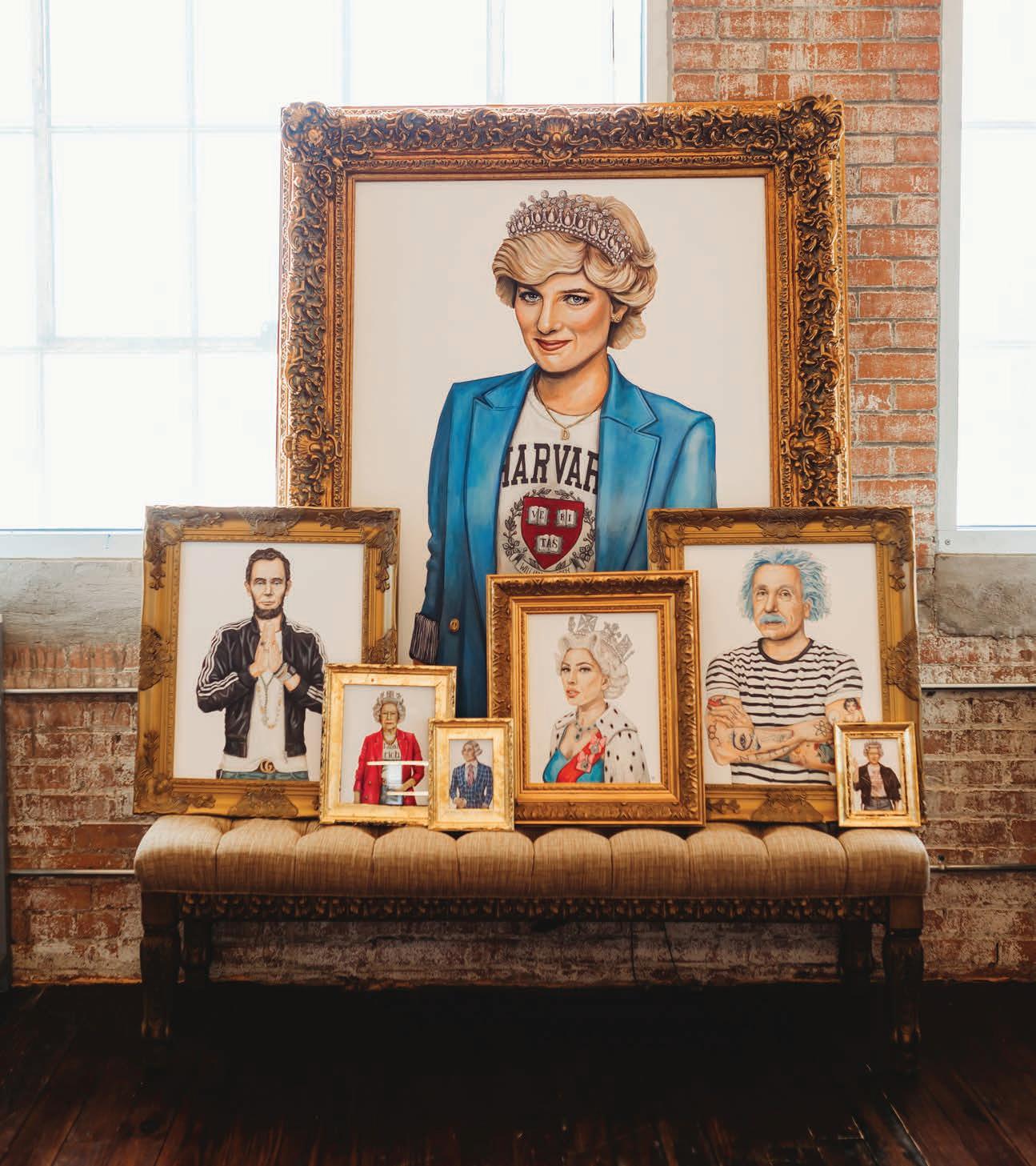










For the past 105 years, the family and its descendants have spent their summers on this riverfront property. The time had come to resuscitate the house.
By Christy Marshall / Photography by Alise O’BrienIn 1918 when the Spanish Influenza struck St. Louis, this Central West End family hightailed it out of town to their property outside of Kimmswick.
“They would spend entire summers here,” says Chelsea Smith, founder of Chelsea Design Company and the designer assigned to whiplash the existing aging farmhouse into the 21st century stunner. “There’s a train track at the bottom of the hill and the dad would actually take it into town.”
In the 1940s, the family built a new house and over the years, added on … and on. “There was a rambling original farmhouse that had several bastardized editions put on it,” says Randy Renner Jr., founder and co-owner of Period Restoration, the contractor on the project.
Smith adds, “Each [addition] had different ceiling heights, and different floor heights. But it actually created such a really unique layout because of the renovations.”
The primary architect, Chris Henson, then with Tim Hollerbach Design and now with Dial Architects, says, “At first [the clients] just wanted to do an addition but we pushed them to the edge. And then we pushed them further … over the edge.”
Urged on by the designer and crew, the homeowners, now in their 80s, wanted to revamp and restore the house without sacrificing its original charm.
“When we remodeled, the goal was to refurbish the home and to organize all of the family’s history, their heirlooms and memories into a time capsule that could be cherished for the next hundred years,” Smith says. “They technically created this for their family so they could experience the same memories, learn about their family history, and make [the house] not a pain or a maintenance headache — like it has been. Everything that we did, we wanted to make sure it was a stunning, durable farmhouse that reflected the family heritage.”




 Smith and her team created the 12-foot long window seat—the perfect spot to river watch or read a great book.
Chelsea Smith designed the stained-glass window. Created by the Cosby Art Glass Co., the flowers and birds are all indigenous to the property. The stone fireplace is original to the house.
Smith and her team created the 12-foot long window seat—the perfect spot to river watch or read a great book.
Chelsea Smith designed the stained-glass window. Created by the Cosby Art Glass Co., the flowers and birds are all indigenous to the property. The stone fireplace is original to the house.
To start, Smith and her assistants packed up every stick of furniture and each belonging. They assessed each piece, photographed it, categorized it and put it into eight storage units. If needed (and it was often needed), items were repaired, refinished, restored.
“They had a lot of incredible pieces that had family history and a family story or that somebody in the family made them,” Smith says. “I actually worked with about 10 different trades in order to refurbish everything.” That renew ran the gamut from lighting fixtures to all the furniture, an antique hooked stair runner (now framed) created by the current owner’s mother, to every area rug. The range of items included handwritten logs of the river traffic, books, paintings of long gone favorite dogs, portraits of family members. “It was kind of like searching through, thrifting through their stuff.,” Smith explains. “I have gone through all of their things, so I know all the things that they have kept. Every book has notes. They kept receipts and documents because everything to them is history and everything to them is important.”

But then again, with such a treasure trove, there was the trick of finding where those pieces should reside. “The goal was to find locations in the new floor plan for as much of the furniture as possible,” Smith says. “There are some things that were obviously purchased or made, but you can’t tell what’s new and what was old unless you know the story behind it.”
The family of the current groundskeeper dates back to the house’s original stone mason. So one of intents of architect, designer and contractor was to incorporate stone into architectural design and to match it seamlessly to what already existed.
The house’s roof and exterior cladding were removed and replaced, the second story was ripped off and rebuilt, an elevator was taken out and a balcony put in its place outside a bedroom on the second floor, an addition was added. The first floor was taken down to the studs. The dining room became the primary bedroom; the powder room was transformed into one of the two primary suite bathrooms. Every bedroom, every bathroom, every room, every inch was redone. In total, the house has seven bedrooms, seven baths.


 Smith commissioned the walnut bed from Goebel & Co. Furniture.
The design of the bath was done with the age of the homeowner in mind. The mirror can be lowered as needed. The height of the vanity was also a consideration.
Smith commissioned the walnut bed from Goebel & Co. Furniture.
The design of the bath was done with the age of the homeowner in mind. The mirror can be lowered as needed. The height of the vanity was also a consideration.
The homeowner came up with themes for the bedrooms. The front bedroom became the Victorian bedroom, because of a set of furniture dating back to the World’s Fair that her mother had gifted her. “The second bedroom was dubbed the Portuguese bedroom because her mother-in-law loved going to Portugal and had just a couple of things from Portugal that didn’t fit with the house,” Smith says. Another bedroom was dubbed the Gold Oriental bedroom and decorated accordingly Although the couple has yet to have great grandchildren, a bunkroom with four brass beds awaits their arrival.

The update went down to the tiniest details. The Chelsea design team restocked the house, picked out every piece of bedding and every towel (three sets of each). Then Smith had her upholsterer add tags specifying where that piece was go. For example, every
sheet, pillowcase and towel in the primary bedroom has a small tag embroidered with “master bedroom.” In the bunkroom, each bed has a brass tag with a number that matches a brass tag on a dresser drawer, a laundry bin and a closet.
Today the elegant farmhouse glimmers in the afternoon sun. The homeowners no longer live in St. Louis but make their way back frequently to their old/new home on the Mississippi. “Their favorite part is that they still see things that they remember being here that are still here,” Smith says. “I just feel like this was a beautiful showcase of what not throwing things away, of what paying attention to your family history, can be … I feel like they’ve taught me so much about how important your family heritage is and how important your family history is to your family.” sl


After making a bold bet with a group of summer English guests to stay in the Swiss town of St. Moritz for the fall season, claiming it to be more agreeable than London, Johannes Badrutt and four Brits who stayed behind would found not only the birth of winter tourism but also put this mountainous town on the map. Some 30 years later, in 1896, Caspar Badrutt followed his father's ambitious footsteps by opening Badrutt's Palace.

Although more than a century has passed, the chateau theme of the Palace remains but on a much grander scale. Most guests arrive in St. Moritz via the Bernina Express, more lovingly known as the Little Red Train, a UNESCO World Heritage Property. The storybook journey wends past villages built on mountainsides and snow-capped peaks while powdery snowflakes fall so gently that it's possible to imagine yourself inside a snow
globe. The pampering begins at the station, where a smartly uniformed Badrutt's Palace chauffeur awaits to whisk you away to the hotel in a Rolls Royce.
It's a short ride up the mountain to the heart of St. Moritz. The scale of Badrutt's Palace is hard to appreciate from the city center: 10 restaurants, three bars, a nightclub, a spa, and an array of other offerings await behind its spinning doors. On the other side, you're greeted by grand wooden vaulted ceilings, with antique and authentic pieces adorning the space, and floorto-ceiling windows to make sure you never miss the beauty of the land that made those English linger longer way back when. Constantly evolving, Badrutt's has carefully crafted a grand hotel that exudes the glamour and glitz you expect from St. Mortiz while also celebrating the local styles and heritage of the area.
Almost 160 years after a bet by Johannes Badrutt created a winter tourism renaissance, Badrutt's Palace continues the family legacy that started it all.
As a historic hotel, there are no cookie-cutter rooms; each tells a unique story. In fact, Alfred Hitchcock famously drew inspiration for The Birds from one of them, and the Palace named room 501 the Alfred Hitchcock suite after his 34th visit. Guest rooms offer opulent touches, including spectacular wooden moldings on the ceilings, antiques, art, and even local crystals in the chandeliers. The marble bathroom in my suite was nearly as large as my Paris apartment!
Guest experiences abound in all seasons. In winter, the obvious main attraction is skiing. As a novice, I appreciated the expertise of the ski pro in the Badrutt's Palace on-site ski shop, although my bunny-ski skills were a far cry from the Olympic athletes she's outfitted for more than 17 years. She aptly demonstrated her prowess by guessing the correct size of our needed gear with a cursory glance.
Having skied only once before, as we ascended the mountain with seasoned skiers, I was worried my flashy ski suit would be the only thing going for me. Spending the morning with Pierre, one of the Palace's resident instructors, quickly allayed my fears. Having worked worldwide with beautiful people like Claudia Schiffer, Pierre remarked that people who've been skiing for decades will still hire him to continue the relationship they've built over the years.
After a day of busting down black diamonds or sticking to the more sedate slants of the bunny slopes, Badrutt’s Palace’s Paradiso is one of the hottest tickets in town. Paradiso sits at the apex of the après experience with a sprawling mountain-view terrace, spectacular food and wine, and a seasonal Gucci-branded lounge. Seizing the moment definitely calls for some fur accessories and bling. While my slope skills don't qualify me to participate in a stylish 007-esque pursuit down the mountain, I did my best to exhibit the effortless glamour of a Bond girl while at Paradiso.
One of the other main attractions of St. Moritz is shopping, and Badrutt's has that covered, too, with its prime location on Via Serlas, the world's highest luxury retail street. They recently opened a Golden Goose storefront on the property, allowing shoppers to create the ultimate souvenir: a shoe from scratch. Just across the street, Badrutt's Palace partners with the likes of Gucci, Louis Vuitton, Cartier, and more locally-known European brand Fusalp (their Emilio Pucci ski suit might make you want to rethink taking more ski lessons) to cater to any and all shopping fantasies. There's even the possibility of arranging private shopping at any point, even at two in the morning. During this past ski season, Louis Vuitton opened a second-of-its-kind branded Khazastan-inspired yurt pop-up. Guests of Badrutt's Palace receive special access to this one-of-a-kind shopping extravaganza.





 Living room of the Helen Badrutt Suite
Paradiso. Photo by Steve Herud
St. Moritz Suite
The Grand Hall at Badrutt’s Palace
Living room of the Helen Badrutt Suite
Paradiso. Photo by Steve Herud
St. Moritz Suite
The Grand Hall at Badrutt’s Palace



Like their shopping experiences, Badrutt's dining options cater to all palates and appetites. A short walk across the street from the hotel leads you to the center of the village and the 364-year-old Chesa Veglia. This former Swiss farmhouse specializes in authentic Italian pizza, elegant French cuisine, and rustic Swiss specialties (and where truffle is never lacking). For an even more authentic experience, you can ask for a private candlelit dinner in the wine cellar of the original Badrutt family farmhouse. The prices of the rarest among the 30,000 bottles it holds rival the Rolls Royce that brought me to the hotel.

What had been the hotel's tennis hall, the first in Europe, is now La Coupole-Matsuhisa, which offers Japanese-Peruvian delicacies by chef Nobuyuki Matsuhisa, or as many know him, the man behind the infamous Nobu empire. The star-studded roster continues with King's Social House, helmed by Michelinstarred chef Jason Atherton. The food is just as spectacular as the
after-party, when the restaurant transforms into a nightclub, with table service consisting of sparklers and Dom Perignon. Finish off the night in the Renaissance bar, where you can pair your cocktail from their choice cigar collection and truly feel like the James Bond villain.
They say the new statement pieces are experiences; material objects are briefly exciting, but adventures stoke the fire of our memories for a lifetime. The highlight reel from a stay at Badrutt's Palace encompasses moments big and small, from indulgent treatments in an underground spa with a heated outdoor infinity pool so you can watch the snowfall to a simple touchpoint of a musician playing the harpsichord every morning at breakfast every carefully crafted encounter creates unforgettable moments. And if that wasn't reason enough to return, the property is building a new addition across the street to ensure that coming back again and again is a safe bet. sl


Fine jewelry inspired by the rich heritage, culture, and landscape of the American West.



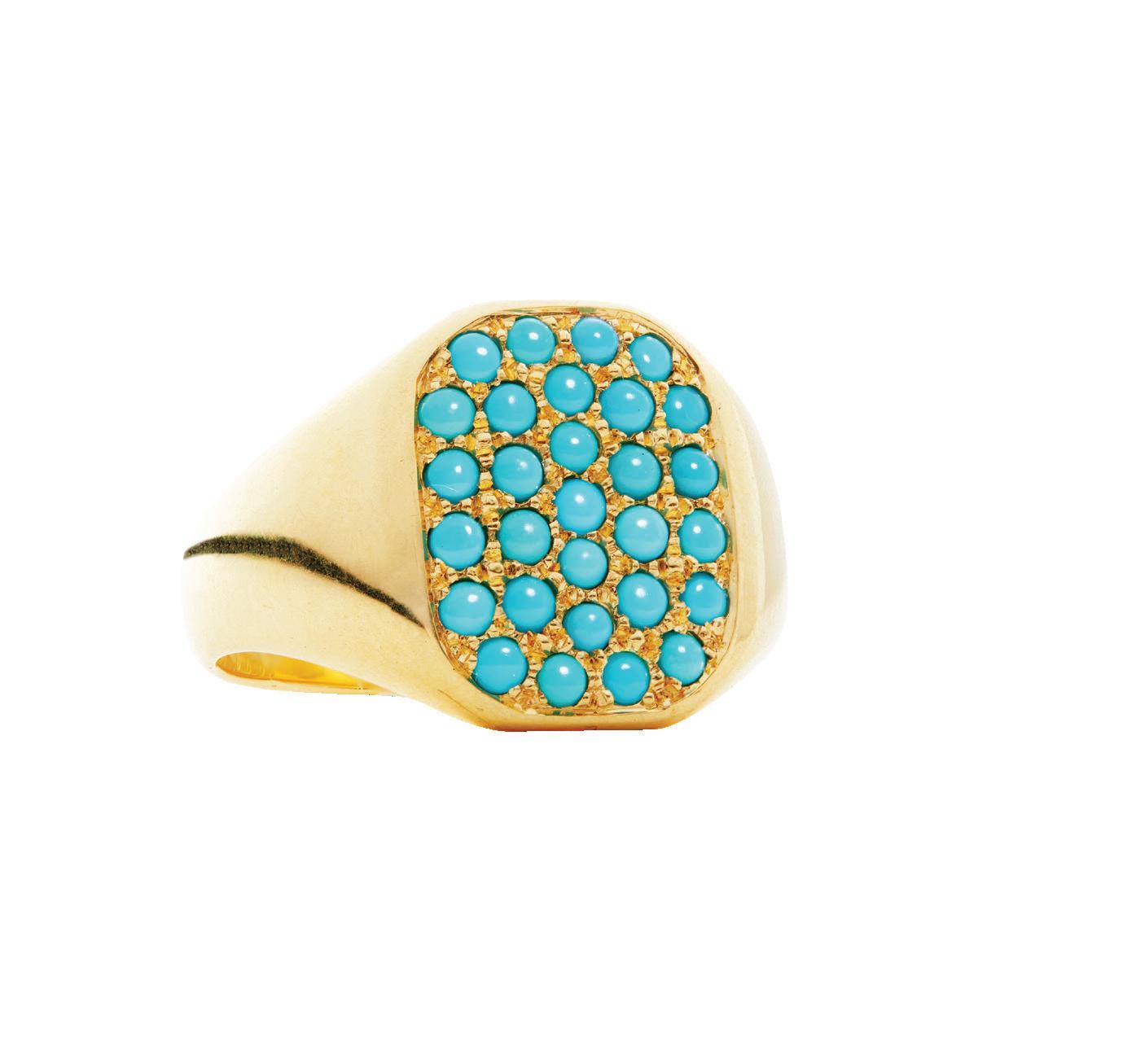



 Compiled by Bridget Williams
Compiled by Bridget Williams
Jill Heller squash blossom vintage silver and turquoise necklace (jillhellerjewelry.com). Jenna Blake beaded necklace ($4,800; jennablake.com). Turquoise nugget necklace Seaman Schepps ($17,500; seamanschepps.com). Nunchaku earrings from Nak Armstrong ($1,275; nakarmstrong.com). Penacho ring from Colette ($4,770; colettejewelry.com). Marlo Laz Southerwestern ring ($2,400; marlolaz.com). Cece Jewellery A Traveler’s Tale ring ($10,600; cecejewellery.com). Signet ring with turquoise Hibiscus medallion from Nouvel Heritage ($5,600). Available through Reis-Nichols in Indianapolis, Ylang Ylang in St. Louis and nouvelheritage.com. David Yurman Petrvs horse amulet in 18K yellow gold ($1,450). Available through Diamond Cellar in Columbus, Moyer Fine Jewelers and Reis-Nichols Jewelers in Indianapolis, Davis Jewelers in Louisville, and davidyurman.com. One-of-a-kind Leo necklace from Emily P. Wheeler ($26,000; emilypwheeler.com). Effy 925 sterling silver and 18K yellow gold diamond bracelet ($1,365; effyjewelry.com). Jacquie Aiche Thunderbird cuff bracelet ($17,500; jacquieaiche.com). Fancy yellow diamond solitaire from Albarré Jewelry in St. Louis ($22,000; albarre.com). Karina Brez Fearless Feathers ring ($1,900; karinabrez.com).





















 Compiled by Bridget Williams
Compiled by Bridget Williams
Opposite page, clockwise from top left: Yvonne Léon grey diamond solitaire bracelet ($3,179; yvonneleon.com). Anita Ko emerald heart chain bracelet ($2,975; anitako.com). Harakh Sunlight collection earrings with .72ct colorless rose-cut diamonds ($5,000; harakh.com). Bondeye Jewelry Calming Clear Shield bracelet ($790; bondeyejewelry.com). Nana Fink blue heart pendant with hand-carved emerald ($3,100; nanafink.com). Shay Colombian emerald solitaire studs ($8,860; brokenenglishjewelry.com). Ashley Zhang mint green tourmaline bubble pendant ($2,000; ashleyzhangjewelry.com). Ramona Albert Bloom ring with aquamarine ($7,700; ramonaalbert.com). Marco Bicego Petali Collection extra large flower ring ($4,900). Available at Diamond Cellar in Nashville and Columbus; Reis-Nichols Jewelers in Indianapolis; Davis Jewelers in Louisville; Simons Jewelers in St. Louis, and at us.marcobicego.com. Sidecar engagement ring with 4ct emerald-shaped diamond from Phillips House ($150,000; phillipshouse.com). Kassandra Nicholson ruby teardrop earrings ($1,820; kassandranicholson.com). This page, clockwise from top left: Akaila Reid Ridge Edge solitaire ring ($32,920; akailareid.com). Tejen Collection Iconic Collection 5mm diamond capstone split ring (tejen-collection.com). Sorellina Cigno cocktail ring with 4.50ctw opal ($9,000; sorellinanyc.com). Rebel Black ring from Thelma West (thelmawest.com). Verragio Renaissance-973-R Two Tone ($3,000, excluding center stone). Available through Genesis Diamonds in Nashville, and at verragio.com. Shahla Karimi Mid-Century Kahn emerald ring with cigar band (from $2,290; shahlakarimi.com). VRAM Chrona demi ring with bicolor tourmaline (vramjewelry.com). Chris Ploof tension setting ring in 18k yellow gold and stainless steel Damascus, setting for .20ct diamond ($4,550, excluding center diamond; chrisploof.com). Continuity ring with .50ct diamond from White/Space ($6,650; modaoperadi.com). Unheated 7.20ct lavender sapphire solitaire from Albarré Jewelry in St. Louis ($24,000; albarre.com). Ray Griffiths Crownwork ring with bezel set Aquaprase ($4,170; raygriffiths.com).













It was love at first bite on my inaugural trip to New Orleans. However, in my case, the ardor was auditory rather than gustatory. Having arrived after midnight due to a frustrating series of airline snafus and eager to make up for lost time, I set out just after sunrise to stroll the empty alleyways of the French Quarter. Much to my surprise, as the first rays of sunlight latched onto the Romeo spikes found on the posts supporting the ornate iron galleries that serve as launching pads for countless beads, street corner musicians had already set up shop to tickle the ears of tourists. While I couldn't discern whether they were extreme early birds or hanger's-on from the prior evening's revelry, I appreciated the distinct sense-of-place soundtrack for my wandering.
After working up enough of an appetite to justify grabbing a bag of warm beignets from Café Du Monde that I'd intended to enjoy in The Eliza Jane's large and lushly landscaped open-air courtyard, I spent the rest of my walk back to the hotel vigorously dusting the evidence of my early indulgence—a preponderance of powdered sugar—off of my ill-chosen black leggings.
Opened in 2018, The Eliza Jane is fashioned from seven 19th-century warehouses that, in past lives, included manufacturing Peychaud's Bitters, publication of The Daily Picayune, and a nondescript Comfort Suites. A two-year renovation stripped away the genericness imposed by the most recent inhabitant to reveal the pleasing patina of the past, including exposed brick, masonry

arches, and metalwork. Located on what was once known as "Newspaper Row," where no less than seven different papers were published in the late 1800s, only one—The Daily Picayune— was the first major newspaper in the country to have a woman at the helm. That woman, Eliza Jane Nicholson, is the hotel's namesake.
Born into a well-to-do Mississippi family in 1843, Eliza Jane sought more from life than marriage and motherhood, so she moved to New Orleans. After submitting several poems to The Daily Picayune under the name of Pearl Rivers, she was hired as the literary editor, earning $25 a week. She went on to marry the paper's owner, Colonel Alva Holbrook, who had sold the paper only to repurchase it after the new owners pushed it to the brink of bankruptcy. Before he could complete the turnaround, Col. Holbrook died, and on the paper's front page on March 26, 1876, Eliza Jane, just 26 years old and $80,000 in debt, announced herself as the owner. She implemented changes to appeal to a broader readership, including adding sections on international news, a society column, and pieces of fiction by notable writers such as Rudyard Kipling and Mark Twain. Her astute business sense and a willingness to surround herself with capable and creative colleagues made the paper one of the most successful in the region. She remained at the helm with George Nicholson, her second husband and the paper's business manager, until they both succumbed to influenza in 1896.
Written by Bridget Williams
 A communal table in The Press Room.
Photo by Taggart Cojan Sorensen
A communal table in The Press Room.
Photo by Taggart Cojan Sorensen
Part of The Unbound Collection by Hyatt portfolio, the 196-room hotel is a short walk from the French Quarter. In my tworoom Editor's Suite, in what was the newspaper's offices, Stonehill Taylor designers opted for an eclectic, homey style executed in jewel tones with a clever mish-mash of unique accessories and art, plush upholstery, and wallpaper. Near the beverage station, classic bentwood Thonet chairs pulled up to a round table accentuated by a vintage typewriter holding a personalized welcome note, to which I added my own hunt and peck addendum. A brushed brass finish on the suite's lighting and bath fixtures encapsulates the forward-looking retro trend.
My suite's wet room took full advantage of the soaring ceiling height by placing a soaking tub in front of a floor-to-ceiling arched window dramatically dressed with drapery. At press time, the property was developing a bespoke line of lime-basil-scented bath amenities, including bath salts, room spray, and velvety hand cream. Eventually, they plan to have these and their line of cocktail bitters (more on that later) for sale in a lobby boutique.
With only one full day on my first visit to The Big Easy, I called on New Orleans Legendary Walking Tours for a half-day jaunt around the city's highlights. After learning of my affinity for a good yarn, especially when it involves ghosts, Dane Rhodes, my guide and a card-carrying SAG member, put on quite the performance. He also peppered his talk with stories of New
Orlean's most notable women, including Mother Henriette DeLille, Micaela Almonester, Rosa Keller, Baroness de Pontalba, Mahalia Jackson, and Leah Chase (all of whom are worthy of a Google search to learn their stories). "New Orleans would not exist without badass women," Dane remarked emphatically.
Our half-day tour ended with lunch at Gris-Gris on Magazine St. (grisgrisnola.com). While Gris-Gris means "bewitch" in Creole, and the restaurant is decked out with Voodoo memorabilia and motifs, it was their chicken and andouille sausage gumbo washed down with a frozen King Cake frozen cocktail that put a spell on me. Chef-owner Eric Cook is a native of New Orleans and a combat veteran who served six years in the United States Marine Corps.
Having checked both King Cake (aboulangerienola.com) and gumbo off of my culinary checklist, I couldn't complete my stay without making a stop at Central Grocery on Decatur Street (cemtralgrocery.com) for an authentic Muffuletta sandwich and Hansen's Sno-Bliz, which has been slinging snoballs since 1939. At the latter, the combination of soft-shaved ice, condensed milk, and flavored syrups made in-house from family recipes created a delightful velvety treat.
After depositing my leftover Muffuletta in my hotel room, I headed down the street to the Sazerac House for a tour to learn about one of the city's most famous exports. New Orleans'
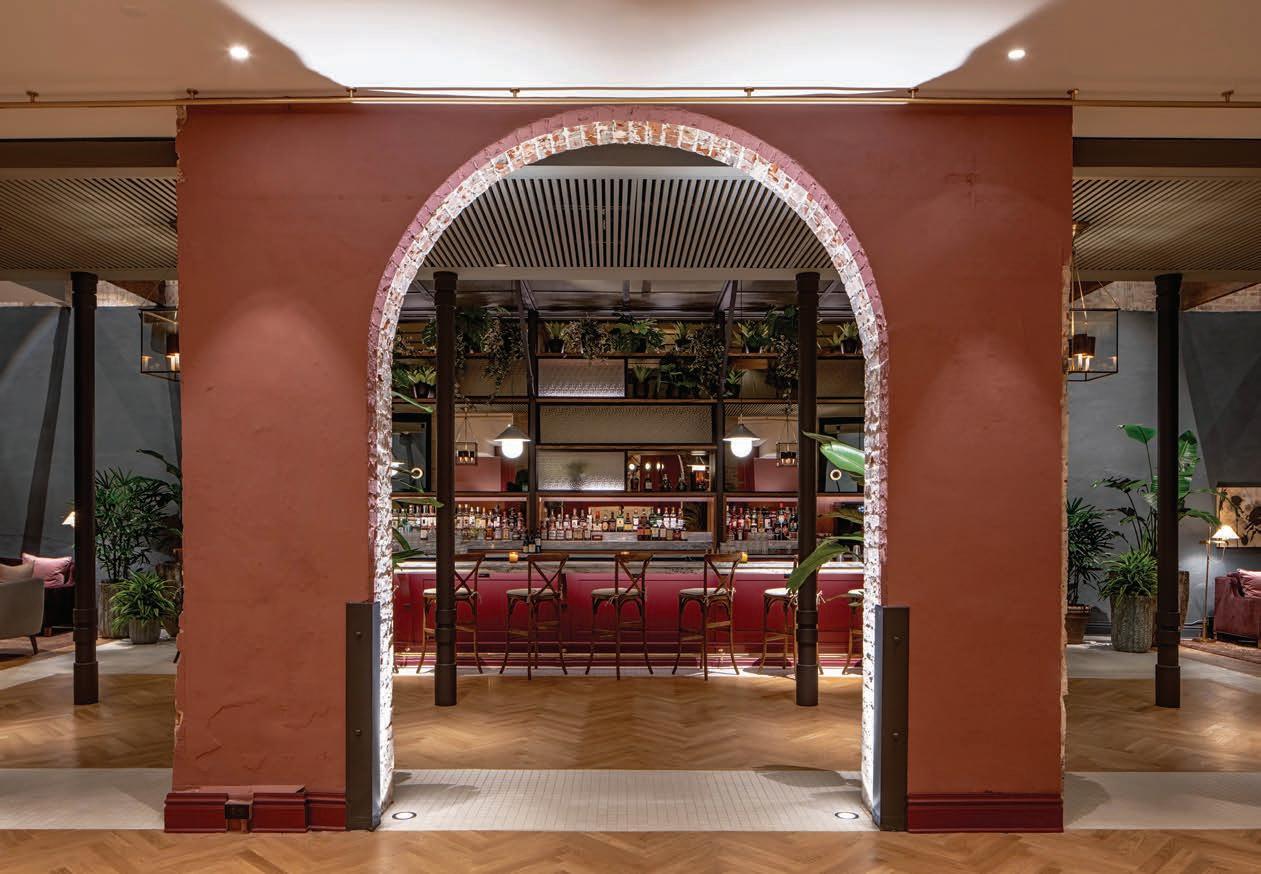 The Press Room, the Eliza Jane’s lobby lounge.
The Press Room, the Eliza Jane’s lobby lounge.
pharmacist Antoine Amédéé Peychaud is famously known for inventing the cocktail in the mid-1800s. His blend of whisky, absinthe, bitters, and sugar, known as the Sazerac, and served in an egg cup called a "coquetier," was initially intended for medicinal use. The well-executed and engaging three-floor museum offers a fascinating deep dive into New Orleans' cocktail culture. Don't ask for the 200-year-old Peychaud's recipe; it's under lock and key as securely as the famous 11 herbs and spices in my home state's famous fried chicken.

Back at the Eliza Jane, Michael Glassberg, Lead Bartender at The Press Room, is developing a proprietary line of bitters for use in the bar based on knowledge gleaned from reading The Standard Manual of Soda and Other Beverages, published in 1897. "Bitters are like a finishing salt for cocktails," remarked Glassberg, who also leads Bitters 101 courses for guests wanting to learn more about creating bitters and crafting cocktails with these herbaceous liquids.

With its library-inspired setting and unique architectural flourishes, the Press Room is a hub of activity day and night. While the cocktail program skews towards a Francophile bent to complement Couvant, the hotel's French brasserie that’s located in the former Peychaid Bittners factory, Glassberg says he relishes the occasional challenge from clientele who hail from around the
world. Complementing the building's history as a welcoming space for women writers, the Press Room is home to monthly "Dear Eliza Jane" author talks in partnership with The Garden District Bookshop.
At Couvant (couvant.com), Executive Chef Ryan Pearson, who cut his teeth working at Restaurant Daniel in New York City before returning to his hometown, explained that the menu looks like what would result if a French-born chef was dropped into New Orleans. Pearson employs a minimal waste, snout-to-nail approach in his kitchen, and I regretted not having more time to sample Couvant's decadent and delicious fare. I did, however, partake of duck and waffles for breakfast and enjoyed a feast fit for a queen at dinner: Provençal flatbread, classic gougères, a beet salad with locally procured strawberries, tagliatelle topped with mushrooms from a family-run small farm in Saint Francisville, Louisiana; côte de boeuf with a black garlic bordelaise, and brioche-crusted veal.

Walking (more like wobbling) out of dinner at Couvant, which followed a "to die for" day of over-indulging in New Orleans' culinary delights, I recalled a framed quote by Insta-poet Atticus that I'd spied in a shop window earlier that day that read, "I hope to arrive to my death late, in love, and a little drunk." To this, I'd add, "completely stuffed." sl For
 more information about the Eliza Jane, visit theelizajane.com.
A frozen king cake cocktail at Gris-Gris Brioche-crusted veal at Couvant.
Duck and waffles for breakfast at Couvant
more information about the Eliza Jane, visit theelizajane.com.
A frozen king cake cocktail at Gris-Gris Brioche-crusted veal at Couvant.
Duck and waffles for breakfast at Couvant
A gathering dedicated purely to elegance and design amidst the grounds of the storied Villa d'Este in Lake Como, Italy, the Concourso d'Eleganza was held for the first time in 1929.
Awarded by a Jury, Best of Show went to a 1935 Duesenberg SJ Speedster styled in the coachwork design by Gurney Nuttin and owned by William Lyon of the United States.

In addition to the trophy, the victor received an 1815 Chronograph crafted by A. Lange & Söhne with a hand-engraved Concorso d'Eleganza Villa d'Este crest on the hinged cuvette.
Gary Cooper, Clark Gable, Greta Garbo, James Cagney, and many other stars of the silver screen drove a Duesenberg during the 1930s. In 1880, the company's founders, Fred and August Düsenberg, emigrated from Westphalia, Germany, to the USA. Speedy successes in motorsport and a small series of exclusive models quickly made them a household name. The marque's crowning glory came in 1932 with the extravagant SJ model. As much as 320 hp was available when the supercharger kicked in, propelling the colossal car to around 140 mph. Speaking to the quality of its vehicles, the turn of phrase "it's a Duesy" arose in the popular lexicon as a general indication of luxury.
Beyond the top prize, the participants and competing vehicles at the Concorso battled it out for victory in individual categories. The Coppa d'Oro prize awarded by Public Referendum went to a
1961 Ferrari 250 Syder California with
by Pininfarina/ Scagliette and owned by Jonathan Hu, Keybridge Collection of Hong Kong. Helmut Käs, Head of BMW Group Classic and President of the Concorso d'Eleganza Villa d'Este, presented the Trofeo del Presidente to Rob Walton of the United States, owner of a 1968 Ford GT 40. BMW Group Classic brand ambassador and star tenor Jonas Kaufmann presented the Trofeo Il Canto del Motore for best engine sound, as chosen by the Jury to a 1970 Porsche 917 K to Christophe Count d'Ansembourg of Belgium.
Pagani's Huayra Codalunga, boasting Bronzo Aymara livery with an exposed carbon fiber finish, exclusive vintage leather and upholstery, and fine Loro Piana fabric, won the Design Award in the "Concept Cars & Prototypes" category, an award created in 2022, besting stiff competition that included Bugatti's W16 Mistral.
"The Huayra Codalunga is a tribute to Italian coachbuilders and race cars from the 1960s, cars that I love so much and that take me back to when I was a child," commented Horacio Pagani, Founder & Chief Designer. "We are happy to have won this award the first time we have participated in the most exclusive and historical classic car event in the world, in a category that represents the link between the automobile's glorious past and its exciting future." sl The 2024 event is scheduled for May 17-19.
Written by Andre JamesThe coveted Best of Show trophy at the Concourso D'EleganzaVilla d'Este
went to a 1935 Duesenberg SJ Speedster.




 Photo by Gudrun Muschalla
Best of Show timepieces by A. Lange & Söhne.
Photo by Gudrun Muschalla
Bugatti W16 Mistral Pagani Huayra Codalunga
Photo by Gudrun Muschalla
Best of Show timepieces by A. Lange & Söhne.
Photo by Gudrun Muschalla
Bugatti W16 Mistral Pagani Huayra Codalunga
At its global debut at Auto Shanghai this past April, BMW solidly demonstrated the seamless interaction of its XM Label Red’s electric motor with a V8 engine. The company shifted gears at Coachella Valley Music and Arts Festival a few weeks later by assembling a global team of like-minded next-generation artists and cultural creators to express themselves alongside boldly styled Sports Activity Vehicle.
“Our goal is to be at the heart of where the creative magic happens – and Coachella is an excellent platform to foster new conversations with emerging talents as well as established artists,” said Stefan Ponikva, Vice President Brand Communication, Brand Experience. “BMW wants to enable artists – musicians, designers, actors, storytellers – to express themselves and engage with our brand and the first-ever BMW XM.”
The company’s claims are not mere hyperbole as the 738hp Sports Activity Vehicle, expected to cost in the neighborhood of $186k, can sprint from a standstill to 60 in 3.7 seconds, making it the most powerful BMW M road vehicle ever made. Top speed is electronically limited to 155 mph or 175 mph when the optional M Driver’s Package is specified.

The M HYBRID system of the BMW XM Label Red blends the virtues of electrification with the traditional qualities of a high-revving 8-cylinder combustion engine with M TwinPower Turbo technology. The 4.4 liter V8 engine alone produces 577 hp at 5,600 rpm – a 94-hp increase over the unit in the standard BMW XM. Peak torque is 553 lb-ft – an increase of 74 lb-ft over the standard model – and is available from 1,800 to 5,400 rpm.
Drawing energy from a high-voltage lithium-ion battery integrated into the underbody, the electric motor also employs innovative technology to deliver a noticeable increase in power. The permanently excited synchronous motor is integrated into the 8-speed M Steptronic transmission together with its power electronics and helps to provide precise throttle response and nearly instantaneous power delivery. The electric motor, which enables an estimated electric-only range of about 30 miles at speeds up to 87 mph, contributes up to 194 hp to the maximum system output of the BMW XM Label Red, along with 206 lb-ft of torque.
The Combined Charging Unit of the M HYBRID system enables AC charging at up to 7.4 kW. The high-voltage battery
Written by Andre James / Photos courtesy BMW GroupWith a 738-hp plug-in-hybrid powertrain, the 2024 BMW XM Label Red is the most powerful member of the BMW M family.
takes just 3.25 hours to be replenished from zero to 100% charge. In addition, predictive heat management reduces charging times by preconditioning – warming or cooling – the HV battery. The charging cable stows away in a weekender bag secured in the rear cargo area using a carabiner-belt combination in M tricolor.


The M xDrive all-wheel-drive system is rear-biased, imparting the BMW XM Label Red a dynamic sense of agility and poise, especially in 4WD Sport mode. An electronically controlled differential lock in the rear axle further enhances traction, agility, and directional stability.

Standard equipment for the BMW XM Label Red includes adaptive M suspension Professional – featuring electronically controlled dampers and active roll stabilization with Active Roll Comfort to eliminate body roll on one side of the vehicle – and Integral Active Steering. The M Sport braking system comprises six-piston, fixed-caliper brakes at the front and single-piston, floating-caliper units at the rear.
Distinguishing exterior features of the BMW XM Label Red include an available Toronto Red metallic accent band
instead of the standard black. The use of red also extends to the model badges and the wheel inserts. The BMW XM Label Red is fitted as standard with 23-inch light-alloy wheels, with 22-inch wheels available as a no-cost option. The surrounds for the BMW M kidney grille and diffuser elements are finished in Black high-gloss.
Customers can select either Brooklyn Grey metallic or choose from more than 50 BMW Individual special paint finishes at no additional charge. In addition, the new BMW Individual Visualizer (bmw-m.com) is available from the start of orders for the BMW XM Label Red to help customers with the paint selection process.
The bold design continues inside the cabin with a rear passenger area modeled after a luxurious lounge, complete with diamond quilted BMW Individual Vintage Merino leather seats set beneath a three-dimensional sculptural prism headliner containing 100 separate LED lights.
Production of the 2023 BMW XM Label will begin in August of this year at the company’s plant in Spartanburg, South Carolina. sl

Thirty years after the presentation of the Boxster concept car, Porsche will launch the most powerful version yet of the popular mid-engine roadster: the new Porsche 718 Spyder RS, which will celebrate its public premiere on June 8 as part of a livestream event in Stuttgart-Zuffenhau marking 75 years of Porsche sports cars (youtube.com/@porsche). The following month, it will appear at the Goodwood Festival of Speed in England (goodwood.com).
"With an engine taken directly from racing, the 718 Spyder RS offers a driving experience like no other," says Kjell Gruner, President and CEO of Porsche Cars North America. "Slicing around a tight corner with the top off and the engine soaring to 9,000 rpm is an experience you will never forget."
The new 718 Spyder RS is a counterpart to the 718 Cayman GT4 RS. The same lightweight powertrain with high-revving engine characteristics also powers the Porsche 911 GT3 Cup racing car. The four-liter six-cylinder boxer engine generates up to 493 hp and 331 lb.-ft. of torque. Combined with a short-ratio seven-speed PDK transmission, the engine catapults the twoseater roadster from 0-60 mph in 3.2 seconds. Compared to the
previous 414 hp 718 Spyder without the 'RS' designation, the 718 Spyder RS boasts an additional 79 hp and accelerates to 60 mph 0.5 seconds quicker toward a top track speed of 191 mph. In addition, paddle shifters on the steering wheel allow drivers to keep their hands on the wheel even when shifting gears manually.
Weighing slightly more than 40 pounds, the exceptionally light soft top of the 718 Spyder RS makes the engine's iconic and instantly recognizable sound an even more stirring experience. A standard lightweight stainless steel sport exhaust system and distinctive combustion air inlets on the sides behind the headrests further heighten the effect.

Consisting of two parts—a sunshield and a weather protector— the single-layer soft top can be used with the sunshield alone. Both are entirely removable and stowable in the vehicle.
Sporty character defines the inside of the car, too, with a Race-Tex-covered GT Sport steering wheel with yellow 12-o'clock marking, standard full bucket seats made of lightweight CFRP in a carbon-weave finish, and perforated Race-Tex seat centers in a contrasting color with a black background. Available exterior colors
Written by Andre James / Photos courtesy of Piaggio GroupThe 2024 Porsche 718 Spyder RS is the most potent version of the popular mid-engine roadster.
include four standard and three metallic paints, including the new Vanadium Grey Metallic and the special colors Arctic Grey, Shark Blue, and Ruby Star Neo.
An optional Weissach Package is defined by forged magnesium wheels, titanium sport exhaust tailpipes, an exposed carbon fiber hood, carbon fiber combustion air scoops on the sides, and a carbon fiber Gurney flap on the rear spoiler. Inside the cabin, the upper part of the dashboard is covered with Race-Tex, while the seat headrests boast embroidered "Weissach" logo.
Owners of the Porsche 718 Spyder RS have exclusive access to a handcrafted chronograph by Porsche Design, and made by the Porsche watchmaking operation in Solothurn, Switzerland. Designed to match the configuration of the car, the case is made of titanium, the dial is made of carbon fiber and the strap is made of vehicle leather. The rotor on the back reflects the respective wheel design on the 718 Spyder RS.

The new 2024 Porsche 718 Spyder RS carries an MSRP of $160,700, excluding $1,650 for delivery, processing, and handling. Arrival at U.S. dealers is expected in spring 2024. sl



For many, the world of wine is mainly monochromic: white, red, and pink. As a result, vino drinkers may think that the world of spirits gets to have all the fun experimenting with colors and flavors. However, you may be surprised to learn that there is a long history of colorful winemaking.
In the red winemaking process, colors ranging from pale ruby to deep garnet result from allowing the juice from the crushed grapes to macerate with skins. Winemakers tinker with the maceration period, which can be anywhere between three to 100 days depending on what effect they want the skins to have on the wine, such as creating a rosé from a short maceration period, increasing wine flavor, tannin, or the viscosity (the body) because many flavor and phenolic compounds come from the grape skin. Contrarily in the white winemaking process, the skins are customarily discarded, giving white wines completely different characteristics, mouthfeel, and flavor.
Orange wines are an outlier. More technically referred to as "skin-contact wine" due to the winemaking process, orange wines are essentially white wines that take a page from the red wine-making book; counter to their moniker, citrus fruit is not part of the equation. Instead, the skins of the white grapes ferment with the juice to impart the wines with a range of colors ranging from medium amber to deep copper. Voila, orange wine!
Georgia (the country, not the state) is considered the "cradle of wine," with the archaeological record crediting wine creation to the people of the South Caucasus in 6,000 BC. Although it's enjoyed a resurgence for the past few decades and is a product of almost all of the world's wine-producing regions, orange wine has been among Georgian winemakers' métier for many millennia. Slovenian and Italian-made are also well-known, with new world wine regions, such as Australia, South Africa, and the United States, following suit.
While orange wines come from various grapes, they're often described as robust and full-bodied with a great depth of flavor,
akin to red wine, due to the grape skin contact, with the bonus of boasting the refreshing qualities of white wine. Common tasting notes include bruised fruit like apple, honeyed aromas of jackfruit (a fleshy tropical fruit), juniper, sourdough, dried orange rind, and savory flavors like hazelnut and apricot.
Notable orange wines include an Italian orange pinot grigio. The Italians use the word to Italian pinot grigio made in an orange wine style, known for honeysuckle, stone fruit, and citrus flavors.

For a complete departure from Italian riesling presents a tartness that is off-putting to some and endearing to others whose palate prefers complex sour flavors. The 2019 Orange Riesling from Bannister Wines in California's northern Sonoma County has flavors of quince, pomelo, tart apple, and allspice that will evolve with bottle aging (bannisterwines.com/ shop/2019-orange-riesling). Whereas other wines have limitations, orange wines like Bannister's Riesling fill the space of wines that pair well with more exotic and spicier cuisines.
Gerard Bertrand's Genora Orange wine from the south of France, made from four white grape varieties, presents aromas of white flowers, candied fruits, and white pepper. The wines' freshness pairs perfectly with aperitifs, cheese platters, and Indian and Asian dishes (en.gerard-bertrand.com/en/products/genora).
Another memorable wine on the color wheel is orange's cousin: yellow. Also known as "vin jaune," yellow wine is white wine exclusively produced in the Jura region in eastern France from the local grape variety, the Savagnin. Only four regions or appellations d'origine contrôlée (AOC) are authorized to produce it: Arbois, Côtes du Jura, Château-Chalon and Etoile. Legend has it that a winemaker found a forgotten barrel in his cellar and opened it to find "the Gold of Jura."
Today the process is not one you should wait around for: after fermentation, the wine is kept for six years and three months in oak barrels without "topping up," meaning that the wine that


 Written by Bridget Williams
Written by Bridget Williams
I'm fairly certain that it's part of our collective DNA as Americans to have some modicum of affection for the lore and legend of the American West. I am not immune to these fascinations, part of which spurred an early and enduring interest in Southwestern archaeology, an unwillingness to part with a childhood collection of American West knick-knacks, and a wholehearted willingness to don a cowboy hat and boots when given a chance. The opportunity arose a few months ago during a visit to the Hotel Drover in the heart of the historic Fort Worth Stockyards National Historic District.
The anchor of the award-winning Mule Alley, a collection of 100-year-old horse and mule barns wonderfully refurbished and repurposed for entirely different types of horsing around, Hotel Drover is a chic cathedral of cowboy culture, whose name honors the pioneering spirit of Texas cattle drivers. Best exemplified by a signature neon cowboy installation by Austin artist Evan Voyles, varying and carefully calculated kitsch sprinkled throughout the indoor and outdoor public areas and the 200 guest rooms and spa suites pulls the heartstrings and adds a kick-off-your-boots welcoming spirit to the rustic-luxe design that belies the hotel's relative newness.
Far from cookie-cutter, Hotel Drover employs antique and bespoke pieces to encapsulate a distinct sense of place. From a signature scent with notes of fine leather, campfire, mango, and pepper (and coming soon to a branded candle); to Hotel Drover-
branded leather check-in booths; hand-forged chandeliers; Los Poblanos lavender-scented bath amenities sourced from a small maker in New Mexico; Rose Ann Hall hand-etched glassware in the restaurants; contemporary artwork; and lounge chairs upholstered in cowhide and dripping with fringe, the design artfully engages all of the senses. For me, it's the minor touches that attest to a hotel's attention to detail, and the chilled eucalyptus-scented towels in the workout room were the perfect post-workout olfactory pick-me-up.
Each spacious guestroom is unique, with most being in either a Texana, Frontier, or Republic style. Our Texana room was chockfull of vintage cowboy and cowgirl imagery, embossed leather, distressed wood, and a lively-tiled bathroom with a stainless steelskirted soaking tub—a perfect blend of fun and fancy.
In the Hotel Drover's "backyard," a $4 million investment in landscaping alone makes this a verdant and quiet oasis that makes the hustle and bustle of nearby Mule Alley seem miles away. Among the amenities are a refreshing pool; an arbor-covered private event space where Executive Chef Grant Morgan offers "adventurous" seven-course dinners; firepits with available s'more and mobile bar service; and an acoustic stage complete with seasonally changing murals of pin-up style cowgirl paintings by a local artist that's the site of the Drover Unplugged music series.



 The lobby of Hotel Drover
Private dining is available in the Hotel Drovers “backyard.”
The lobby of Hotel Drover
Private dining is available in the Hotel Drovers “backyard.”


 The Lucchese Fireplace Suite at Hotel Drover
Sweet and spicy bacon at 97 West
The Lucchese Fireplace Suite at Hotel Drover
Sweet and spicy bacon at 97 West
At the entrance to 97 West, whose design pays homage to Wild West outlaws, dueling vintage prints of Tonto and the Lone Ranger with weapons drawn flank the entry. The menu features elevated ranch classics and reimagined comfort foods. Their brunch is stellar, with our favorites being the brunch taco board, sweet and spicy bacon (served "clothesline style" above jalapeno cornbread, and a decadent giant cinnamon roll served piping hot in a cast iron pan. The Lobby Bar, The Backyard, and The Courtyard at 97 West all offer chic spaces for sipping seasonallyinspired craft cocktails.

It's just a short walk down Mule Alley to Exchange Avenue, where twice a day, drovers parade longhorn steer, fascinatingly aware of the awe-inspiring span of their hood ornaments, down the street that's often lined three-deep with onlookers. An initiative conceived around the 150th anniversary of the city's founding, Fort Worth is the only city in the world to own a herd and employ full-time drovers. "It's important to remember that we're a cow town," said Ed Brown, the lead ambassador for the Stockyards. His entertaining and enthralling historical tours of the area touch on lore, legends, and why it came to be known as "hell's half-acre." As
he spoke, my head filled with hazy images of crushed red velvet and whiffs of stale tobacco and whisky breath.
The entirety of The Stockyards is a playground for grownups, with scores of dining, shopping, and entertainment options. From embellished boots and cowboy hats to colorful embroidered dresses, big hair, and shiny belt buckles, the predominant style among the throngs milling around the several-block area is the antithesis of "quiet luxury." Highfalutin folks flock to the Lucchese boutique in the Hotel Drover's lobby (lucchese.com). Here, specially trained staff offer the company's only "sole to scallop" custom boot experience that begins with an in-depth foot tracing and consultation. Options for personalization are limitless, making the experience of designing these wearable works of art akin to a tattoo that you can take off.
Proper Supply Co. (@propersupplycofw) offers another highstyle souvenir. General Manager and Creative Director Christina Falconer uses steam and know-how to hand-shape a beaver fur felt hat into your chosen style (I opted for a classic Cattleman crease). A self-taught hat shaper, Falconer cut her teeth at the rodeo, and under her direction, the shop showcases an eclectic mix of upscale cowboy couture. "I love being the voice of artisans," she remarked.
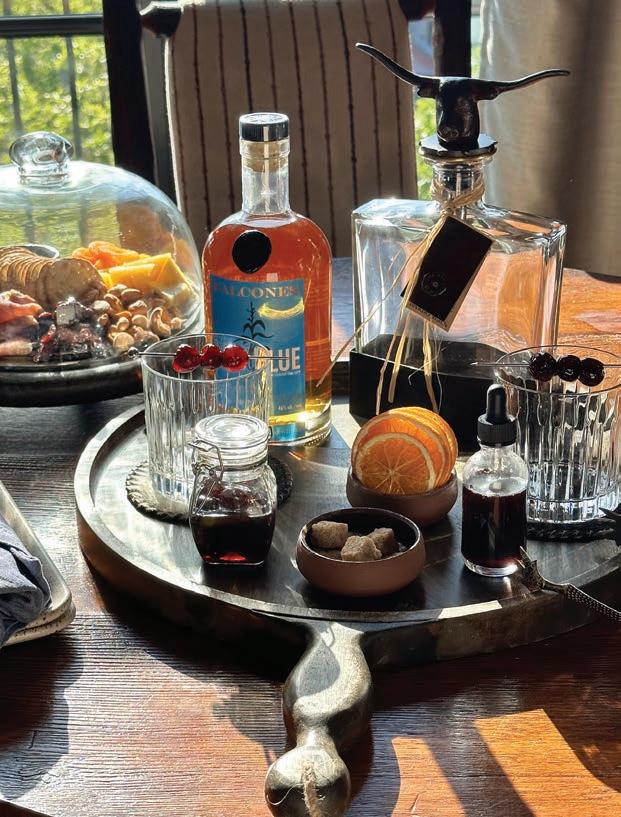



Proving that the world is indeed a small place, during our private hat party, Taylor Samuels, owner of Los Almas Rotas mezcal bar in Dallas, was on hand and offered me a "ranch water," a Texas-style tequila or mezcal highball made with lime and Topo Chico. As we chatted, he casually mentioned that he, too, was from my hometown of Louisville. "You might know my dad, Bill," he said casually. That would be Bill Samuels, Chairman Emeritus of Maker's Mark. So, of course, I asked why he opted for a south-ofthe-border spirit over Kentucky's most famous export, to which he replied, "Agave is a terroir spirit that makes mezcal more interesting because every batch is unique."
One thing is for sure in The Stockyards: you won't go hungry. Chef and entrepreneur Tim Love is the drover of dining here, with six distinct outlets: Paloma Suerte (palomasuerteftx. com); Tannahill's Tavern & Music Hall, where Hotel Drover has a dedicated balcony suite (tannahills.com); the alfresco Love Shack Burgers (loveburgershackfortworth.com); Lonesome Dove Western Bistro (lonesomedovefortworth.com); the White Elephant Saloon, famous for hosting Fort Worth's last gunfight (whiteelephantsaloon.com); and Caterina's (caterinasftx.com). Each of Love's outlets is a highly personal expression of his passions and affection for his friends and family.

Generating as much buzz as its elevated Italian cuisine are the jackets-required, phone-banned policies at Caterina's. Love, who said he got in a "huge" fight with his wife over the no phones policy, said the idea came to him after being seated next to an influencer at a restaurant in Miami who made a big spectacle filming their entire meal. Phones are placed in a neoprene case and locked at the door.
To assuage the anxiety of being so close and yet so far, patrons are presented with a complimentary glass of rosé Prosecco.
"Italian food is my favorite to cook," said Love, adding that he appreciates the focus on few and fine ingredients paired with proper technique. The high-ceilinged dining room at Caterina's is intimate and lively. Sitting in what was a hayloft, it was fun to peer over and see a sea of cowboy hats. Not content with resting on his celebrity chef laurels, Love said he frequently works the line in his various restaurants to keep his skills sharp. He's also recently dipped his toque into fashion, launching the Love Collection in Tannahill's Tavern's Goods and Chattels shop (goods-chattels.com).
Appropriately attired with new boots and a hat, we further immersed ourselves in cowboy culture with a stop at John Wayne: An American Experience (johnwayneae.com), a 10,000-squarefoot museum dedicated to the life and films of The Duke with 400 pieces of personal and professional memorabilia. Just outside The Stockyards is the National Cowgirl Museum and Hall of Fame (cowgirl.net), the only museum in the world dedicated to honoring women of the West.
The crowning event of our extended weekend stay was the Stockyards Championship Rodeo (fortworthstockyards.com), the world's only year-round rodeo every Friday and Saturday night. As this was literally my first rodeo, I was enthralled by the athleticism of horse and rider and totally swept up in the energy of the packed house.
As we reflected on a whirlwind visit, the Texas-sized hospitality most resonated. It's a way of doing business that Ed Brown aptly summed up by remarking, "We don't have tourists; you're our guests." sl For more information, visit hoteldrover.com.
An available and locally-inspired in-room amenity at Hotel Drover.
Grand Seiko limited-edition SBGZ007 with Caliber 9R02 ($79,000). Available through Richter & Phillips Jewelers in Cincinnati, Moyer Fine Jewelers in Indianapolis, Davis Jewelers in Louisville; Diamond Cellar in Nashville; Clarkson Jewelers in St. Louis, and grand-seiko.com.

Breitling Top Time B01 Ford Thunderbird with Breitling Manufacture Caliber 01 and “squircle” sundials ($8,450). Available through Richter & Phillips Jewelers in Cincinnati, Moyer Fine Jewelers and Reis-Nichols Jewelers in Indianapolis, Clarkson Jewelers in St. Louis and breitling.com.
To mark the second Miami Grand Prix this past May, IWC Schaffhausen released a version of its Pilot’s Watch Chronograph 41 MercedesAMG PETRONAS Formula One™ Team with a “Miami Pink” rubber strap ($8,350). Available through Reis-Nichols Jewelers in Indianapolis, King Jewelers in Nashville, Simons Jewelers in St. Louis and iwc.com.


OMEGA 43 mm 150M Seamaster Aqua Terra Worldtimer in steel and integrated green rubber strap with grey stitching ($10,200). Available through Richter & Phillips Jewelers in Cincinnati, Moyer Fine Jewelers in Indianapolis and omegawatches.com.
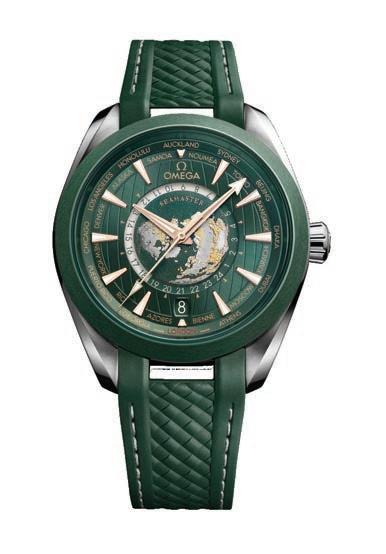
Cartier Santos-Dumont watch, large model ($6,000). Available through Diamond Cellar in Nashville, Simons Jewelers in St. Louis, and cartier.com.

The 42 mm BR 03-92 PATROUILLE DE FRANCE 70TH ANNIVERSARY from Bell & Ross is intended to celebrate the anniversary of the Patrouille de France, an elite unit of the French Air and Space Force, founded in 1953. Limited to 999 pieces ($4,100). Available through Diamond Cellar in Columbus, Moyer Fine Jewelers in Indianapolis, King Jewelers in Nashville, and bellross.com.


TAG Heuer Monaco chronograph, 39 mm in titanium ($11,250). Available through Diamond Cellar in Columbus, Moyer Fine Jewelers and ReisNichols Jewelers in Indianapolis, Davis Jewelers in Louisville, King Jewelers in Nashville, Clarkson Jewelers in St. Louis and tagheuer.com.

Rolex Oyster Perpetual 36 mm ‘Celebration” with calibre 3230 ($15,100). Available through Richter & Phillips Jewelers in Cincinnati, Diamond Cellar in Columbus , Reis-Nichols Jewelers in Indianapolis, Davis Jewelers in Louisville, Clarkson Jewelers and Simons Jewlers in Nashville & St. Louis and rolex.com.
Black Bay GMT 41 mm from Tudor Watch with Manufacture Calibre MT5652 ($3,975). Available through Richter & Phillips in Cincinnati, Diamond Cellar in Columbus, Reis-Nichols Jewelers in Indianapolis, Davis Jewelers in Louisville, King Jewelers in Nashville, Simons Jewelers and Clarkson Jewelers in St. Louis and tudorwatch.com.
The Histories American 1921 from Vacheron Constantin reinterprets a model launched more than a century ago for the American market ($30,400; vacheron-constantin.com)

The center of the dial on the Patek Philipps 5531G is adorned with a cloisonné Grand Feu enamel motif. Available through The Diamond Cellar in Columbus & Nashville and patek.com.











 Compiled by Colin Dennis
Compiled by Colin Dennis





 Borneo wallpaper mural from Isidore Leroy (from $1,068; isidoreleroy.com)
Sensi Studio Trinado lampshade hat ($189), halter maxi cover up ($297), and mini Mochica bag ($270; sensistudio.com)
Sense Studio Dumont hat ($306), oversized boyfriend shirt ($264), low waist pants ($186), straw carryall ($474; sensistudio.com)
Borneo wallpaper mural from Isidore Leroy (from $1,068; isidoreleroy.com)
Sensi Studio Trinado lampshade hat ($189), halter maxi cover up ($297), and mini Mochica bag ($270; sensistudio.com)
Sense Studio Dumont hat ($306), oversized boyfriend shirt ($264), low waist pants ($186), straw carryall ($474; sensistudio.com)




Crafted entirely in teak and rust-finished metal the OUT-FIT compact outdoor gym from Ethimo and Studio Adolini is designed for use in the outdoors, from the beach to private terraces ($18,900;
 Seal gown from the Hydra collection by Liz Martinez (lizmartinez.co.il/hydra-collection/)
Yves Delorme Bahamas bedding collection (usa.yvesdelorme.com)
ethimo.com)
Seal gown from the Hydra collection by Liz Martinez (lizmartinez.co.il/hydra-collection/)
Yves Delorme Bahamas bedding collection (usa.yvesdelorme.com)
ethimo.com)
St. Louis has been graced with the magnificent glass art creations of Dale Chihuly in private collections, museum collections and two exhibitions in conjunction with the Missouri Botanical Garden, first in 2006 and now thru October 15, 2023 in what is called “Chihuly in the Garden 2023.” The artist’s world-renowned glass sculptures have captivated audiences around the globe. His presence here has added a new dimension to the city’s artistic landscape, creating a visual spectacle that enchants and inspires all who encounter it, more than doubling the garden’s attendance during his first show and hopefully eclipsing that for his second.

Both the 2006 exhibition and the one currently on display transform the garden’s lush landscapes into a magical wonderland
of glass art. Spectators marvel at the sight of Chihuly’s radiant glass sculptures nestled among the foliage, reflecting light and color in a harmonious dance with nature. Garden President, Dr. Peter Wyse Jackson, noted “’Chihuly in the Garden 2023’ will be our most ambitious exhibition to date,” he says. “Chihuly’s art, designed specifically for the botanical garden setting, captures the imagination. As these works are especially mesmerizing at night, we’re delighted to also offer our Chihuly Nights experience.”
The installations are transcendent when illuminated at night. Visitors can enjoy live music and entertainment as they stroll the Garden. Chihuly Nights runs Thursdays through Sundays, until August 27. Doors open at 6 p.m.
Written by Craig Kaminer / Photos by Nathaniel Wilson“The power of light has always fascinated me—how the light changes throughout the day and into dusk,” Chihuly was quoted as saying in a recent St. Louis Magazine article. “I love to see how my work changes with the light. After dark, the landscape disappears, and the experience with the artwork is completely new.”
“Our first exhibition with Chihuly in 2006 was so successful that we thought about bringing it back again,” says Vickie Campbell, vice president of Visitor Operations at MoBOT. “About four years ago, we started talking to the Chihuly Studio about what would make sense, knowing we were going to have a brand new $100-million Taylor Visitor Center with new south gardens. We thought this would intrigue Chihuly, as well. After four visits, working with our new environment, they curated this one-of-akind show expressly for us. “There are now 20 Chihuly installations on the Botanical Gardens’ 79 acres.”

Chihuly’s artistic journey began in the early 1960s, when he started experimenting with glassblowing techniques at the University of Washington. Over the years, he pushed the boundaries of the art, exploring its limitless possibilities and redefining the medium’s capabilities. His distinctive style is characterized by bold, vibrant colors, intricate patterns, and organic forms inspired by nature.
The Missouri Botanical Garden serves as the perfect backdrop for Chihuly’s creations, allowing visitors to experience the interplay between art and the environment. The delicate glass herons, lyrical reeds, and ethereal orbs seem to come alive, as if they were an intrinsic part of the botanical wonders surrounding them. Chihuly’s installation not only elevates the garden’s beauty but also sparks a dialogue about the relationship between art, nature, and human perception.
In addition to the Missouri Botanical Garden, Chihuly’s presence has extended to other notable locations in St. Louis. His artwork has graced the Saint Louis Art Museum, where visitors have been enthralled by his glass chandeliers and intricate ceiling installations. The juxtaposition of Chihuly’s contemporary glass art within the museum’s classical architecture creates a captivating visual contrast, highlighting the timelessness and versatility of the medium.
Moreover, Chihuly’s impact on St. Louis extends beyond the confines of galleries and gardens. His work has inspired local artists and ignited a renewed appreciation for glass art within the city’s creative community. Many emerging artists have been drawn to the medium, inspired by Chihuly’s ability to infuse glass with life and capture its inherent beauty. St. Louis has become a hub for glass art enthusiasts, fostering a vibrant and inclusive environment for the exploration of this captivating art form at places such as Third Degree Glass Factory.
 Dale Chihuly
Dale Chihuly
Dale Chihuly’s legacy in St. Louis goes beyond the transient beauty of his installations. His work serves as a reminder of the transformative power of art, capable of transcending boundaries and inspiring awe and wonder. Through his innovative approach to glass art, Chihuly has pushed the limits of the medium and brought it into the realm of pure artistic expression.
The installation on this issue’s cover is called Float Boats. According to Campbell, “The interesting story about this is there’s also a film that we got from the Smithsonian that talks more about Chihuly and how he does things. He does the boat series and he does the chandelier series. The Float Boats came about because he was throwing pieces for the chandeliers that he was going to hang. He was just throwing them off a bridge into the water. Then they’d get picked up and they’d hang [the piece] in a tree or they’d hang it under a bridge. Chihuly watched the assistant who was in the boat pick up the balls and put them in the boats. And he said, ‘I like that. I’m going to do that.’ So that’s where he came up with that unique piece.”
One of the signature pieces of the installations is called Summer Sun. It was transported in boxes to St. Louis in five 53-foot trucks and took three days to put together. In all, it took 10 people three weeks to install all the Chihuly pieces throughout the gardens.

As visitors to and residents of St. Louis encounter Chihuly’s glass creations, they are transported into a world of imagination and beauty. The interplay of light, color, and form evokes a sense of wonder, inviting contemplation and introspection. Chihuly’s presence in St. Louis has elevated the city’s artistic landscape, infusing it with a sense of enchantment and awe-inspiring creativity.
In a city known for its artistic fervor, Dale Chihuly has left an indelible mark. His glass art installations have become integral to St. Louis’ cultural identity, inviting both locals and tourists to explore the intersection of art and nature. As St. Louis continues to evolve as a cultural destination, Chihuly’s contributions will remain an enduring testament to the transformative power of art and its ability to shape and inspire communities. sl
FOR A FAMILY RETREAT OR PRIVATE CORPORATE NEEDS, OVERLOOK FARM IS A SURPRISING AND INSPIRING OASIS OFFERING ITS FIVE INNS AVAILABLE FOR LEASE FOR THE FIRST TIME IN ITS STORIED HISTORY.





RELAX. PLAY. LIVE.
Just 75 minutes north of St. Louis!
overlookfarmmo.com
CEDARCREST MANOR Nestled among a cluster of towering cedars and tucked away just up the hill from the city of Clarksville. Built in 1842 by Captain Benjamin Clifford, a prominent riverboat captain, Cedarcrest began its life as a plantation home and quickly became the archetype for a number of houses built in the Mississippi River Valley. Romanesque pool which creates a quiet, and restful place to relax and recharge. Rich with amenities, this enchanting Missouri inn is adorned with antiques and features a fireplace in every room.
RACKHEATH HOUSE Perched atop the hills of the Mississippi River Valley, and situated just a short walk from the Overlook—one of the highest spots along the river. Built in 1860 and restored in 2006 by Nathalie Pettus, this Greek revival-style manor features sprawling grounds, a spacious veranda, and a romantic, flourishing garden filled with gorgeous walking paths. Its accessible, state-of-the art kitchen and elegant dining room provide guests with the ideal place to uncork a bottle of wine or sip a cup of coffee.
GREGG WILLIAMSON

(cell) 314-359-9210
(office) 314-677-6254
GreggWilliamson.com

BRIDAL COTTAGE An intimate space for couples to get away. Perched above the meadow, surrounded by rolling hills, it provides beautiful views of the sunrise and sunsets. A guest will find a full kitchen and beautifully decorated bedroom creating a weekend you’ll never forget!
AVALON HOUSE By far one of the most breath-taking views on the property overlooking the Mississippi River. This home is perfect for retreats of any occasion. Avalon House is fully furnished with four bedrooms, four bathrooms, a kitchen, and a wrap-around deck.

Alex Pifer grew up in Clearwater, Florida and her favorite bagel shop stood next door to her high school. “I’ve been a lifelong lover of bagels,” she says. “I moved around the country and I always found the bagel shops … until I moved to St. Louis.”
Today Alex has her own bagel business, Baked & Boiled. “I’ve mostly been a chef but I always wanted to get into baking because it’s fascinating,” she says. “It’s borderline alchemy. During the pandemic everything shut down but bakers and butchers still did well. I thought that was what I should probably get into. It took me at least 8 months to a year to make a really solid bagel.
“I’m a bagel snob,” Alex adds. “My husband is Jewish so he is no stranger to a good bagel. He really, truly enjoys them. Baking in general makes me happy.”
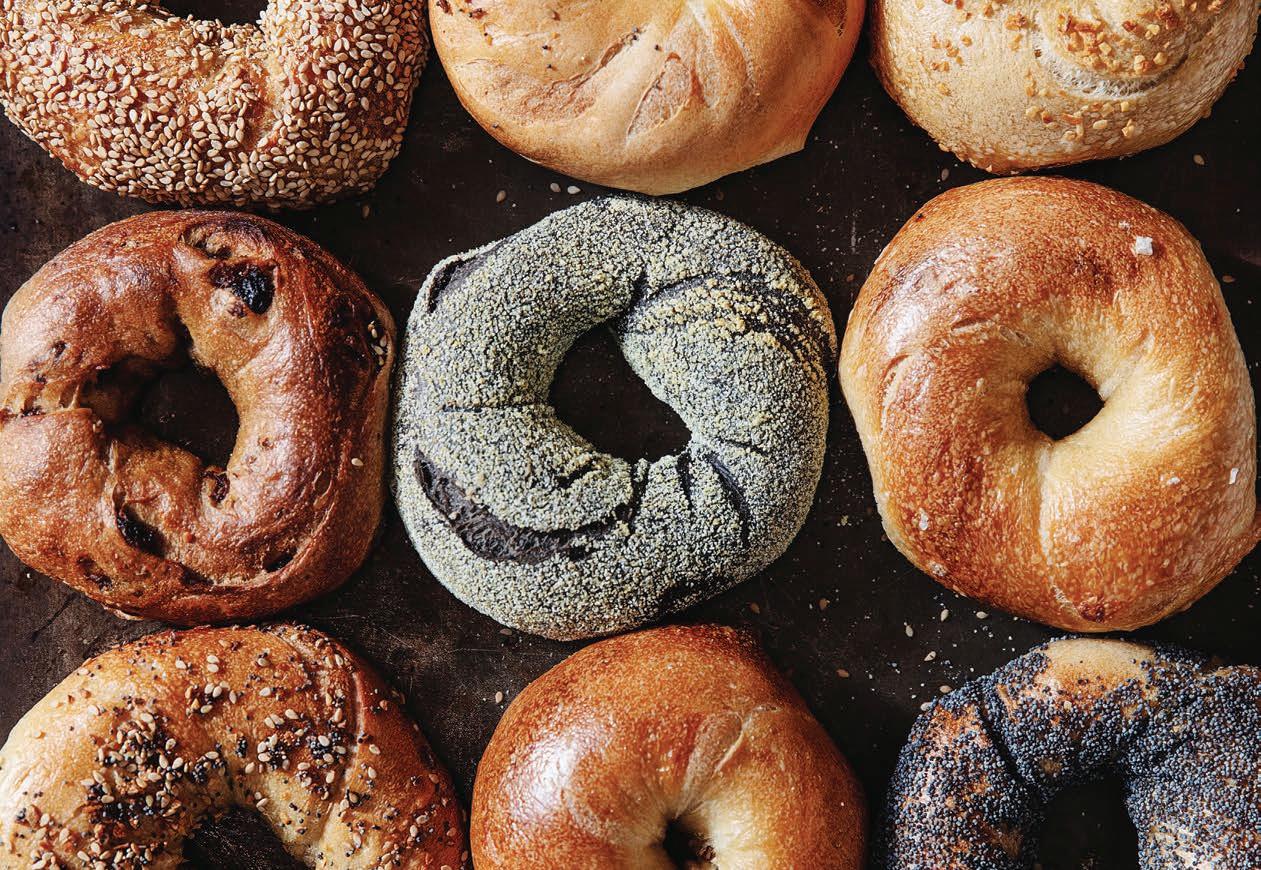
At first, Alex sold at a pop-up at Wild Olive Provisions in the Shaw neighborhood but quickly her business started picking up steam. She formally opened Baked & Boiled in May, 2022; last April, she started baking at Carondelet Bakery. Sugarwitch gourmet ice cream sandwich creators, Martha Bass and Sophie Mendelson, own the bakery and rent out space as incubator kitchens for small businesses “It has a huge five-level rotating oven that worked out perfectly for bagels,” Alex says. “I’m still baking there.”
Baked & Boiled offers a variety of bagels including a ghost pepper cheddar, a jalapeno cheddar, rosemary sea salt, as well as the standards
of the Everything, sesame, poppy, onion, chocolate chip, plain, and cinnamon raisin. To prepare for her weekly sales at the Tower Grove Farmer’s Market, Alex bakes on Fridays until “2:30 a.m., which gives the bagels time to cool,” she says. “We load up and get there around 6:30 a.m. The market opens at 8 a.m. and we sell out by 10:30. We’re trying to make it to 11:00 but no matter how many bagels we make, we sell out at 10:30.” She bakes about 50 to 55 dozen weekly.
Aside from Tower Grove, Baked and Boiled Bagels are available at Zoomie’s Pet Café on Macklind. But Alex has set her sights set on a shop. “Ideally, I will be opening my own storefront as soon as possible and hopefully in the Shaw area. We have built a customer base and the families continue to come.”
Heading West to Chesterfield at the corner of 141 and Olive Street Road, Scott “Lefty” Lefton and Doug Goldenberg, brothers-inlaw, teamed up to open Lefty’s Bagels. Neither of them has a culinary or business background. But when Scott’s local Einstein’s Bros. Bagels shuttered, he started baking bagels at home.
After months of trial and error, Doug says “He finally produced something that was pretty decent.” After friends and family egged him on, he started baking at a co-op bakery then called the Baker’s Hub and now known as the Trolley Stop Bakery.
“We started with a six-month commitment to go in and bake. It was fairly risk free for us because we didn’t have to have any capital
When the Bagel Factory closed in December, St. Louis lost its only bagel shop. Today the bagel business is booming.
expenditure. And, it was a great excuse during COVID to get out during the weekends in a fairly safe environment.”
The initial goal was to sell a dozen dozen or 144 bagels weekly. They breezed by that end zone almost immediately.
“After about three weeks, we had lines forming as much as an hour before we’d open the doors, and we’d sell out in an hour,” Doug says. “It stayed that way for the entire time that we baked there, which is about a year-and-a-half in total. We were making dough in very small batches and 20-quart mixers. We were hand rolling them and boiling in kitchen stock pots. We were baking in convection ovens that are all wrong for what we were doing.”
So, the brothers-in-law decided it was time to expand and to build their own bakery.
They created a business plan and started researching bagel establishments in other cities. They did one 12-hour whirlwind tour of Chicago’s best bagels. From New York, Doug says they drew a lot of inspiration from Zucker’s Bagels.



“We knew that we had a great bagel product and that in the process of expanding, we wanted to ensure that we maintain the quality of the bagel, but not degrade the bagel by bringing in other types of ingredients that are just subpar,” Doug says. “For example, for a bacon, egg, and cheese, I don’t want to bring in subpar bacon because that would just degrade our quality bagels.”
The shop is open from Tuesday through Sunday from 7 a.m. to 2 p.m. A sign specifies that Rabbi Jeffrey Abraham of Congreation B’nai Amoona has certified the bagels as kosher. But Doug explains, “It is not a kosher facility. We have the best of both worlds. We have kosher bagels and bacon.”
Union Loafers founders and co-owners Ted Wilson and Sean Netzer were ready to expand their fledgling empire. While Netzer said any new venture “has to fit neatly under the umbrella of carbohydrates,” they decided to try bagels.
“We weren’t immediately drawn to it for a number of reasons, but the more we thought about it, the more we were like, ‘Oh, there’s a gap in the market here,’” Sean says. “There’s not a ton of spots that are taking bagels seriously. It just took us awhile to come around to the idea. It was really the fact that not a lot of people had talked about bagels. Bagels aren’t a rite of passage here the way they are in Montreal or New York or L.A. So, I think part of it was just we didn’t know if it was something that people even wanted. And clearly, we’ve been set straight on that.”
The duo found a vacant Porter’s Paint store at the corner of Elm Avenue and Big Bend in Webster Groves. “We signed the lease in fall of 2019, right before COVID,” Sean says. “And then we were hoping to do the built out and be open in late 2020.” The pandemic derailed that schedule.
Filling an order at Lefty’s Bagels. Boiling the bagels at Bagel Union“In 2022, we hit the ground running, ordering everything that we needed, getting the contractors in there, doing the build out and just trying to get our ducks in a row,” he continues. Opening day was February 8, 2023 and lines snaked down Big Bend waiting to get into the shop. “It’s great to see the support,” Sean says. “It’s been amazing.”
Selling out is not an uncommon occurrence at Bagel Union but Sean wants customers to remember that the shop is baking bagels all day long. “Even if we’re out of the particular bagel that you want and this usually only happens on the busiest of days, we’ll take your phone number down and just call you when they’re ready.”
Baking a bagel is a three-day process. At Bagel Union, Sean said there is a special emphasis on the hand-rolled aspect of the job. “We bought a bagel shaper and we don’t use it because we didn’t like the texture that it was putting out of the bagels,” he says. “There’s always room for improvement. But as far as what we’re going for, we want something crunchy on the outside, chewy on the
inside, but not so dense as the bagels that are kind of everywhere. So, we want a little bit more open and airiness and a little bit more fun to eat and to fill with cream cheese.”
During the week, Sean estimates they bake 1,000 bagels daily but 3,000 on the weekends. The shop opens at 8 a.m. and closes at 2 p.m., Wednesday through Sunday.

Looking ahead, Netzer said Bagel Union is planning on going into catering “and just keep growing, make it sustainable, keep it local, and keep it fun and interesting for our staff.”


The bonanza in bagels roars on. Ben Poremba sells New York-made bagels at his new restaurant Deli Divine. If you’re longing for a Jerusalem bagel (which is lighter and longer than the regular and isn’t boiled), you can find them at Poremba’s restaurant, Olio. Across the river in Wood River, C&B Boiled Bagels has opened and word on the street has it that the Bagel Factory will be reopening on Olive Street Road.
At last, there’s a bagel boom in St. Louis. sl
Alex Pifer of Baked & Boiled, with a tray of her yet-to-be baked bagels. Lunch at Deli Divine

In 1934 in Greenville, Illinois, Ralph Nevinger wanted to keep the score of a basketball game. So he created a simple white oak cabinet with a glass dial clock and glass disks. Nearly nine decades later, that small one-man enterprise has grown into Nevco Sports LLC, the oldest and the largest privately held scoreboard company in the world with operations still in Greenville, as well as Edwardsville and Highland, Il. It is the leading designer, manufacturer, and marketer of customized sports scoreboards, integrated LED video boards, electronic display signs, scoring, sound systems, and related accessories. The company is considered the industry leader in end-toend scoring and display solutions for sporting arenas internationally.
Locally, you can find Nevco’s creations at Cardinal Ritter, Chaminade, DeSmet, Priory, Washington University, St. Louis University, and Maryville, as well as the Matthews Dickey Boys and Girls Club, among other spots. After the Blues won the Stanley Cup, the team hired Nevco to outfit the new Centene Center where they practice. Beyond our borders, schools such as, University of Central Missouri, Southern Illinois University at Edwardsville, Grambling State, McNeese State University, and Yale University sport Nevco scoreboards. The company has sold to high schools, colleges, universities, recreational facilities and commercial properties in states across the nation. In 2022, Nevco purchased Lynx System Developers, the masterminds behind the technology used for photo finishes at a variety of sporting events, including The Kentucky Derby.
Before the advent of electronic scoreboards, teams relied on manual and rudimentary scorekeeping methods. As sports grew in popularity during the 19th century, more sophisticated methods of scorekeeping emerged. Mechanical scoreboards with numbered panels which could be manually flipped to indicate the scores and times became popular. The most common example of this was the handoperated “flip-dot” scoreboard, widely used in baseball stadiums.
The introduction of electricity in the late 19th century paved the way for the development of electromechanical scoreboards. These
scoreboards incorporated mechanical components driven by electric motors, enabling automated score updates. Electromechanical scoreboards were far more efficient than their manual counterparts and quickly gained popularity. They utilized a combination of rotating panels, light bulbs, and mechanical levers.
The 20th century witnessed a transformative shift in scorekeeping technology with the rise of electronic scoreboards. The introduction of vacuum tubes and later transistors enabled the development of electronic displays. Early electronic scoreboards used incandescent bulbs or neon tubes to display numbers and letters. They provided much brighter and more visible displays.
The digital revolution in the late 20th century brought about significant advancements in electronic scoreboards. LED (light-emitting diode) technology revolutionized the scoreboard industry. LED scoreboards offered enhanced visibility, better energy efficiency, and the ability to display vivid colors. These scoreboards became the standard in sports stadiums and arenas worldwide, offering dynamic displays capable of showcasing animations, video replays, and ads.
Modern scoreboards integrate with various data sources and deliver real-time information to spectators. They feature player statistics, instant replays, game-related graphics, and social media updates. Advanced control systems enable the seamless integration of multimedia content, enhance the spectator experience and provide comprehensive information.
As technology continues to advance, wireless and mobile scoreboards have gained in popularity. Wireless scoreboards eliminate the need for physical connections, enabling greater flexibility in installation and portability. Mobile applications allow fans to view scores and updates in real-time on their smartphones or tablets.
What is fueling the growth of the industry? According to Nevco CEO, Jeff Fiorini, “There’s a megatrend right now where high schools aspire to have what the colleges’ teams have, and the
 Kaminer / Photos courtesy of Nevco
Kaminer / Photos courtesy of Nevco
colleges aspire to have what the professional teams have. So that cascading effect is moving the category from being a traditional scoreboard to a multimedia video display. And we’ve spent a lot of time on improving our controllers that have for years driven that scoreboard. We’re investing in changing the controller technology to be more user-friendly. The kids that are controlling that scoreboard in the next 10 to 20 years want to be able to do it from their phone or iPad. We haven’t launched this yet, but Nevco is getting ready to launch a completely new platform of scoreboard control technology.”
Artificial Intelligence is obviously a hot button for all tech companies, but Fiorini says Nevco is a ways away from that. “The company’s focus in the near term is on pixel pitch where it’s a more clear picture on the video display.” That’s where a lot of the advancement is being done with high school gymnasiums or even high school football fields. And a big part of what Nevco finds is that universities are so competitive to recruit the top talent they are investing millions of dollars on new football fields, arenas and video displays. Even high schools are hyper-focused on having the biggest video display. If a high school down the street puts in a slightly bigger video, they’re chomping at the bit to say, we need a bigger video display. No one wants to be left behind.


Experts agree that within 10 years, the game, scoring, and timing will all be handled differently, with AI and computers, not people. As schools stream more of their games, the technology will improve the fan experience and will integrate stats and historical data, as they are now doing with professional sports.
Congress has allocated $189 billion for Elementary Secondary School Education Relief (ESSER). for public elementary and high schools to ensure that if the schools need a new library or artificial turf or new scoreboards, that money was available. “As a result, the hockey stick that we’ve seen in our demand was a big part of schools being able to upgrade from a
traditional scoreboard to a big video display with the ESSER funds,” Fiorini says.

Other schools raise money for new athletic fields and scoreboards with current parents, alumni and loyal fans of the program. Nevco Sports Marketing helps schools raise the funds for new scoreboards. Working with the school athletic director, Nevco contacts the top companies in each community, raises the money, and puts in the new scoreboard. Moving forward, Nevco shares in that revenue that they created as a way to get paid.
Like sports, if there’s a will there’s a way.
“Some schools are making sports streaming and sportscasting part of the curriculum, which is a really nice advancement for those kids that can’t play on their high school basketball or football team, but they love being part of the experience and they love the energy that comes with a full gymnasium or a Friday night football game,” Fiorini says. “Some schools are moving to a curriculum that actually will help train and educate those kids and they may want to make that part of their career moving forward. When you consider all the mixers and all the instant replay, and communication skills to call a game, there’s a lot of opportunity for kids to play a major role in this for their school.”
The history of scoreboards showcases the remarkable progress made in the field of sports timekeeping. From ancient chalkboards to modern digital displays, scoreboards have evolved to enhance the spectator experience and provide comprehensive information. The transition from manual to electronic scorekeeping methods has revolutionized the way we engage with sports, with scoreboards becoming an integral part of the game. As technology continues to advance, we can expect further innovations in scorekeeping, pushing the boundaries of what is possible and continuing to captivate sports enthusiasts for generations to come.
And Nevco will be keeping score. sl
Nevco CEO, Jeff Fiorini Original Nevco basketball scoreboardNew
When I sat down with Victor Goines, I became infected — infected by his knowledge of jazz. I was bitten by the jazz bug and his enthusiasm for the uniquely American art form. And “jazzed,” pun of course intended, by his insight into how jazz touches and inspires. The man made a believer of me when he spoke these words that will forever be in my ears — “There are only two kinds of people in this world, those who love jazz, and those who don’t know it yet.”
That sentence says everything one needs to know about Goines’ vision—past, present and future.
“St. Louis is one of the four points of the quadrilateral of the American jazz universe,” he says, adding that there are four cities that are the bedrock of jazz: New York, New Orleans, Chicago, and St. Louis.
Goines explains that St. Louis has produced jazz greats, and other musicians that are household names. In that stratosphere are Miles Davis, Clark Terry, Josephine Baker and Velma Middleton. The city has connections that extend all the way back to Louis Armstrong, Tina Turner and Michael McDonald. When he came to St. Louis to take on his role as CEO, he “did his homework,” as any educator would.
“I have roots in St. Louis,” he says. “Unlike many cities in which I have lived and worked and where I knew little, I have known about Jazz St. Louis since it was back at the Majestic Hotel. I knew what it represented. I knew what it stood for,” he adds, as if glancing backward. Through Goines’ eyes I could see the world of jazz made whole. He sees the past. He revels in the present. And he is actively living the Jazz St. Louis slogan to RAISE THE VIBE about what’s happening and move JSL to a place that has a world-renowned reputation beyond a cornerstone of the American jazz quadrilateral. He is making jazz disciples of us all.
Digging deeper and further connecting the notes for me, Goines made it clear why he is the torchbearer of jazz. “Every time an artist comes here, I have at least one relationship with the
whole band. I think that makes it extraordinary for me, because as a performer that is a very unique relationship to have with the talent one recruits,” he says. “As opposed to someone who’s a CEO who is not a performer, or who hasn’t performed at the magnitude at which I’ve been playing throughout my entire life, I can make a different kind of connection. I share with them a different kind of mutual respect than some others may have.”
The Julliard School, Northwestern University, Wynton Marsalis, Dizzy Gillespie, Diana Ross, and Stevie Wonder are but a few of the places and people Goines has either performed with, or at which he has taught. Goines, a renowned jazz saxophonist and clarinetist in his own right, performed at Lincoln Center Orchestra with Wynton Marsalis and the Wynton Marsalis Septet for 30 years. The legendary jazz great Wynton Marsalis recommended Goines for the position of chief operating officer for Jazz STL. Bill Higley, Chair of the JSL Board of Directors says, “We are thrilled to have Victor at the helm with his extensive knowledge and connections to the jazz world.”
Goines will continue to perform around the world and bring back all the wealth of knowledge to hit the high notes in what is now home base — St. Louis. In the upcoming 2023 season, and for years to come, look for heavy hitters in the world of jazz to grace the Jazz St. Louis stage.

Speaking of the future, Goines related a story of how Jazz St. Louis is instrumental in making local youth a part of the jazz cosmos.
“When I first came to St. Louis to start my new position last August, I went to get a haircut at a place on Lindell,” he recalls. “I think it was Supercuts. There were two young ladies having a conversation about a show that they were going to at Jazz St. Louis. I just kept quiet, and, of course they didn’t know who I was or my connection to the club. Then I said, ‘Hey, you know, that sounds like a great show.
Where is this place?’ So, they told me that it was not far away on Washington. One of them said, ‘Yeah, I live right around the corner from it.’” Goines says he asked them if either of them played music.

“One responded, ‘Oh, no!’ Then the other young lady said, ‘Do you play?’ I smiled and said, ‘A little bit.’ Then we just talked, and talked, and the one young lady said, ‘You know I have a son who I’m homeschooling right now and I’d really like him to be involved in some kind of musical program.’” Goines reached into his pocket and gave her his card.
“‘Call this number tomorrow and ask for our education director. Tell him that you talked to me and tell him about your son, and we are going to do what we have to do to get your son into the program,’” Goines says. “Her son is now in the JSL Jazz Academy. He’s a piano player. And guess what?”
Goines waited a beat. “That’s how jazz brings people together. That lady who lives around the corner from Washington Avenue buys her ticket from the same box office that the millionaires do. She soaks in the same sound they do. She might even mingle with them while getting a drink. And someday her son might be a headliner on stage. Jazz is the great equalizer.”
A week after the interview, I was enjoying an evening at JSL with my daughters Amy and Megan. Grammy Award winning bassist and composer Linda May Han Oh was the headliner. Between sets, she took a moment to introduce her fellow instrumentalists. Pointing to her pianist she said, “Tonight we have Fabian Almazan playing the piano and other toys.” Next, she introduced her saxophonist, Greg Ward. “Greg is from Chicago and I just recorded an album with him.” Finally, she bowed to her drummer. “On drums is Obed Calvaire.” She continued by telling the audience that when she had played a set at the club about four years ago, she had conducted a workshop as part of her duties. At the class she was impressed by a 14-year-old student drummer. “Ladies and gentlemen, that drummer is sitting right here and who now tours with me. Thank you St. Louis, for bringing this gifted young man to me. He is a true talent.” The young man stood up with a smile that lit up the room. It brought home the mission of JSL full circle.
Many think that JSL is just a performance space where jazz lovers gather. True, JSL presents more than 270 performances in its internationally acclaimed concert series every year. But JSL is so much more. The non-profit nurtures budding musicians like the once 14-year-old Calvaire and countless like him through the years who go on to thriving careers in the industry. Through programs like the Jazz Academy, JSL presents not only the best of one of the four corners of the American Jazz universe that Goines described, but encourages future audiences to become disciples of jazz.
Orchestrated by Victor Goines, the juggernaut of jazz that is JSL will continue to pull its magnetic force on “those who love jazz, and those who don’t know it yet.”
Long may those words ring true. sl
David Sanborn | Sept. 13–16, 2023
Grace Kelly | Sept. 20–24, 2023
Reggie Thomas celebrates the King Cole Trio | Sept. 29–30, 2023
Yellowjackets | Oct. 4–8, 2023
Jazz St. Louis Big Band Plays Mary Lou Williams | Oct.13–14, 2023
Peter Martin Trio featuring Rueben Rogers & Gregory Hutchinson | Oct.18–22, 2023

John Clayton | Oct. 27–28, 2023
Rene Marie | Nov. 1–5, 2023

Keyon Harrold | Nov. 10–11, 2023
Bill Charlap Trio | Nov. 15–19, 2023

Jeremy Davenport | Nov. 24–25, 2023
Wycliffe Gordon Quintet | Nov. 29 – Dec. 3, 2023
A Very Manley Holiday with Jim Manley’s Mad Brass and Rhythm | Dec. 6–7, 2023

Denise Thimes’ Soulful, Swingin’ Holiday | Dec. 8–9, 2023

Nicole Henry | Dec. 13–17, 2023
JSL Big Band plays Ellington’s Nutcracker | Dec. 21–23, 2023
Good 4 the Soul | Dec. 29–30, 2023
New Year’s Eve with Victor Goines & Friends | Dec. 31, 2023
Marquis Hill | Jan. 3–7, 2024
Billy Childs with Sean Jones & Alicia Olatuja | Jan. 31 – Feb. 4, 2024

Jazz at Lincoln Center Group | Feb. 9–10, 2024
Camille Thurman | Feb. 14–18, 2024
Terri Lyne Carrington | Mar. 6–10, 2024
Jazz St. Louis Big Band featuring Denise Thimes | Mar.15–16, 2024
Anat Cohen Quartetinho | Mar. 20–24, 2024
Herlin Riley | Apr. 3–7, 2024
Luciana Souza & Trio Corrente | Apr. 17–21, 2024
Jason Marsalis | May 1–5, 2024

Sherman Irby | May 15–19, 2024
Carlos Henriquez | May 29 – June 2, 2024
Keyon Harrold | June 12–16, 2024








you are
“I cannot recommend Modern Moving Company enough.



Our team of 4 was courteous, helpful, and careful. They talked to us about what they were doing the whole time and were very flexible and accommodating when we asked them to move more than they had planned.
They NEVER stopped working the whole time and were extremely efficient.
Thanks so much!”
We know that moving can be stressful which is why we’ll do whatever it takes to guarantee your complete satisfaction.
FREE ESTIMATES
On-the-spot estimates that we fully stand behind.
PERSONALIZED SERVICE
A designated contact person will professionally manage your move from beginning to end for consistency and attention to detail.
GLOWING REVIEWS
We’re proud to have achieved a 4.9-star Google rating and A+ from Better Business Bureau (BBB).
Our rubber duckies are pretty cute too.
 Luke Heintz, Founder Saint Louis native and Westminster Christian Academy alumni
Luke Heintz, Founder Saint Louis native and Westminster Christian Academy alumni


Find your dream car. At RP Exotics we have one of the most extensive inventories of exotic vehicles in the nation, so that you can nd exactly what you are looking for, at a fair price.


We know cars, and how to sell them. Through our trusted PROsignment process, we can sell your car fast, while generating a win-win for both parties.

Luke Heintz started working for a small local moving company on weekends and holiday breaks when he was just 15. When he was 20 he figured it was time for him to start his own business, improve on what he learned, and disrupt the moving industry before someone else did. He quickly realized that many customers are not happy with the entire moving process or service. He determined that having clients deal with one person from beginning to end was the best way to do things differently than all the other competitors. He created a well-trained team to not only make the move but to also offer a high level of communications and service at each step of the way.
Modern Moving was founded by Luke just before the pandemic and he figured that things would not go well with everyone staying home. But he quickly found out that people were buying and selling homes at a historic pace, and they all need to move. So what could have been a disaster turned out to be a blessing. Within months Modern Moving picked up a lot of business that the national companies couldn’t handle, and immediately hired 20 employees.
Luke is a fast learner. He discovered that people threw out his business cards so that many of the people he gave them to couldn’t remember his company when they needed a mover. So he started handing out yellow rubber duckies. Something as simple as marketing with rubber duckies turned into a game changer. More than 50 percent of the people he and his team handed rubber duckies to kept the duck and the card. And business grew quickly.
In 2022 with meteoric growth Luke reached out to Monty Jodeh to come in as CEO and partner to manage the growth
and development of a vision for the future of Modern Moving. Monty brought 25 years of entrepreneurial experience and business development, which is exactly what Modern Moving needed for its next phase. A vision was created, a strategy was formulated and is being executed under his direction.
If you choose to call Modern Moving for an estimate (and we hope you will), you’ll find that they have novel approach to something as un-sexy as moving. They start by building a relationship with all of their customers and understanding their expectations. One account person is assigned to each project from the beginning…from your first call to the in-home estimate, to the planning and the specific move date.
By the time the truck shows up on moving day, you will know your point of contact quite well and you’ll find he/she more service oriented than any other moving company you have ever used. Luke evangelizes, “Because you get what you pay for, clients have to feel comfortable with you from step one all the way till the end. I would say that’s the biggest thing that makes us different. We obviously dress the part with khaki pants and collared shirts so people want us to be in their house. Everyone even wears a belt so they look nice and presentable. Modern Moving blanket wraps everything as an extra precaution for all of the furniture. Then throughout the day the one point of contact you know– and presumably like – swings by to make sure everything’s running smoothly with the crew, with the customer, and making sure everyone’s happy. Luke emphasizes, “Because we do that, it’s an infinitely better experience and just works out better.”
 / Courtesy of Modern Moving
/ Courtesy of Modern Moving
Just read these verified reviews. Amit Bery wrote, “Modern Moving Company was fantastic. Hunter was responsive, accommodating, and friendly. He came out personally to look at size of the job to get an accurate estimate (I actually paid less than I was quoted!). His team was incredibly professional. They contacted me prior to being dispatched. They came and efficiently but carefully packed our home. On a separate day, they skillfully moved our stuff with not a single bit of damage. The process was quick, easy, and painless. Best movers I have ever used!”


Luke is a big believer in holding himself and his company accountable. Because he knows when someone is moving and something gets damaged it’s their fault. They can’t be perfect on every move, but they pride themselves on how quickly they take care of the problem. A lot of other companies have attitudes and don’t know why customers get so upset.
“We invest heavily in training and taking care of clients worldly possessions because our clients are investing in us,” Luke says. “So we invest in taking care of them and their possessions.” Regardless of where you move, Modern Moving always uses their own equipment and employees even if it’s out of town. They never broker anything out to United or another well-known carrier. It’s always one of their team members traveling with your things, unloading the truck, and setting it up the way you expect.
The company takes extra care for someone to really pay attention to every detail of what they’re doing. “We go out to every home that we’re moving, we estimate everything, we photographed

everything so that our teams know what they’re walking into and can be prepared for move day. If there’s a 10 foot glass mirror, the team knows about it two days before they even move it so we have a special box on the truck that day. It’s all about the communication. Not just between us and the customer, but between anyone in the front office that knows what’s going on.”
So everybody at Modern Moving gets trained to do the same thing so anyone can jump in on a move and do it exactly as the others would do it. Obviously some people have their skills at being better at one thing and someone else is better at another thing. “As operators of the company, we know those skills and help the team improve, Luke explains,. We will never put someone on packing if they are not good at it. And we give our teams monthly reviews so they know where they need to improve.
“Most movers in St. Louis have terrible turnover, but Modern Moving works hard at building a fun culture, finding and keeping committed people, and most of all, exceeding our clients expectations.” Reflecting on the past few years, Luke says ”This is a crazy business. We’ll have people that schedule six months in advance but we also have someone schedule a day in advance. It honestly just depends on the situation. I have so many people call us when other moving companies cancel day of, so they need us desperately. It happens more than you think. We work hard to move things around and take those clients because helping someone out last minute, it’s an automatic client for life. And we want clients for life!” sl
Founder and CEO, Luke Heintz Upholstered chair wrapped to protect it from the move

July-Sept 3 Action/Abstraction Redefined Modern Native Art,1940s-1970s (slam.org/exhibitions/action-abstraction-redefined-modern-native-art-1940s-197Eltons/)
1-2 Elton John & Tim Rice’s AIDA final performances, STAGES Kirkwood (stagesstlouis.org)
2-4 Fair St. Louis 2023, Arch grounds (fairsaintlouis.org)

7 Let Them Eat Art,Tribute to Bastille Day. Maplewood (cityofmaplewood.com)
14, 18, 28 Art Hill Summer Film Series, Saint Louis Art Museum lawn (slam.org/art-hill-film-series/)
14-21 9th Annual Labute New Theater Festival in St. Louis at the Gaslight Theater (gaslightheater.net)


21-30 23rd Annual St. Louis Filmmaker’s Showcase, Hi-Pointe Theatre (cinemastl.org)
21 Jammin’ at the Zoo Benefit (stlzoo.org)
29 Vincent Stemmler’s “Doom Scroll”.The Gallery at Krantzberg (kranzbergartsfoundation.org/the-kranzberg/
11-13 Blues at the Arch Festival, Arch grounds (archpark.org)
18 St Lou Fringe Festival at The Kranzberg’s ZACK:The Final Performance of Midnight Annie (krantzbergartsfoundation.org/zack/)
18 Jammin’ at the Zoo Benefit (stlzoo.org)
20 Coloring STL Exhibit at the Missouri History Museum (Missouri-history-museum-shop.myshopify.com)
26-27 Evolution Festival, Forest Park (evolutionfestival.com)
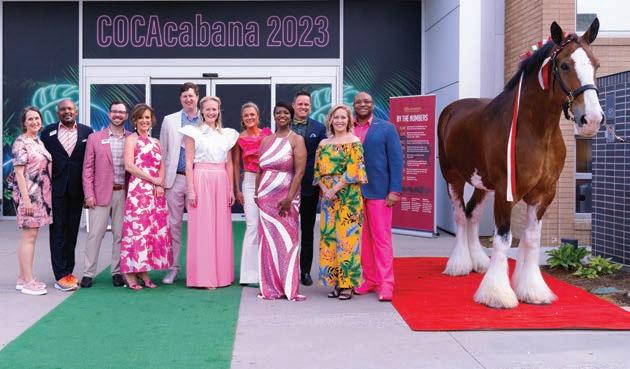

This year’s COCAcabana’s theme was “Electric Oasis: Glowing and Growing at COCA”. The annual fundraising event shined a spotlight on the ways the arts organization champions students to grow and glow. Held on April 28, more than 500 business and community leaders gathered for artistic performances, imaginative games, dinner, cocktails and dancing. The event raises close to a million dollars annually. Those funds account for nearly 20 percent of COCA’s annual contributed revenue. The silent and live auctions added voltage to the Center for Creative Arts, which provides arts programming and scholarships for students attending arts-challenged schools.











Thanks to a heavy assist from the Saint Louis Fashion Fund, Washington University’s fashion students and Mother Model Management, the Met Gala Watch Party held on Monday, May 1 at the Maryland House in the Central West End was a dazzling affair. St. Louis fashion lovers, industry leaders, and rising talent celebrated fashion’s biggest night wearing their best Chanel or Fendi-inspired looks in homage to this year’s theme and the late designer Karl Lagerfeld. What was even more exciting were the diverse and bold creations of the aspiring Washington University fashion students. They created looks symbolizing the future of fashion in the “Lou” ranging from simple and sleek to intricate shadows and silhouettes. “Our DNA in fashion is part of our city’s brand -- at one time, St. Louis’s garment district was only second to New York, “ said Susan Sherman, co-founder of Saint Louis Fashion Fund. “In my opinion, we even rivalled the New York gala fashions!”







Ellie Redders put virtual reality on full display at an event dubbed ER Does VR on Thursday, May 4th. Heavy hitters from the design/build and construction communities gathered at Sandbox VR at City Foundry STL in The Grove. Guests got the chance to see and play the Ellie Redders Interior Design Interactive Game at the cuttingedge virtual reality playground. Butler’s Pantry sparked everyone’s taste buds with appetizers, while Sophisticated Living kept the party going with heady libations.
























Executive Director Patricia Bosman gave a warm welcome at the MOMentous Luncheon, A Celebration of Motherhood benefiting Haven of Grace. More than 400 attendees gathered at downtown’s Missouri Athletic Club on Give STL Day, Wednesday, May 10th. Honorary Chairs Dana and Ron Redwing gave a passionate plea for the organization’s goal of helping pregnant, unhoused mothers and their children achieve permanent housing and success in life. Guests participated in an upscale auction, a raffle for a goldstudded Valentino bag, and a fund-an-opportunity for “Project Lift,” enabling the organization to purchase a new van. The legendary Bosman Twins lit up the stage with a feature performance, as did Emily Wallace, Heather Lawyer, and Devon Cahill for a song of unity and helping each other A huge success, the event raised 150 percent more than last year’s luncheon!



On a lovely spring evening in May, Pedal the Cause hosted its annual Podium Dinner to celebrate theparticipants who raised $25,000 or more for the cause.During the intimate dinner Rich Liekweg, the president, and CEO of BJC Healthcare, received the 2023 Dan and Sheila Breakaway Award. Through the years, Liekweg individually raised more than $250,000 for Pedal for the Cause which provides critical funding for cancer research at Siteman Cancer Center and Siteman Kids at St. Louis Children’s Hospital.







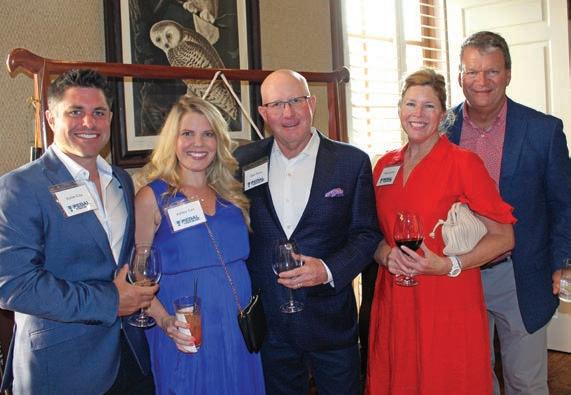
An Evening in the Garden – 2023 on June 2 celebrated the Grand Opening of the $100M transformational Jack C. Taylor Visitor Center at the world renown Missouri Botanical Garden. Nearly 400 attended the sold-out event set against the backdrop of the Chihuly in the Garden –2023 exhibit. Chairs were Kathy and David Hollo, Nancy and John Ross, and Lisa and Steve Trulaske.









In the ever-evolving world of real estate, selling a luxury home requires careful planning, precise execution, and a deep understanding of the current market trends. Looking at the midway mark of 2023, the landscape for selling high-end properties has evolved, presenting both challenges and opportunities for homeowners and real estate agents alike. If you are considering selling your home, here are some things which you need to know:
• The Market is Likely Going to Slow Down. While we still see multiple contracts for above asking price, the market is likely going to slow down. The good news is we’re seeing more houses in the $2-million-plus range hit the market — a sign that the time to sell is now.
• The Market Changes Quickly. We’ve seen the market change in a couple of weeks or a month. Just because things were selling briskly last month doesn’t mean it will be the same when you are ready to sell. You just can’t time the market. If you are ready to sell, there is a buyer out there who is ready to buy.
• Despite 6.7 percent Mortgage Rates, It’s Still A Good Time to Buy. We’re seeing more all-cash offers, but nevertheless, buyers can always refinance their mortgage if rates drop. Remember, buyers are expecting to pay more for homes than they have in the past, so don’t wait to put your home on the market because chances are buyers will then expect to pay less when the market cools off.
• Backlog of New Construction. Buyers for newly built homes are growing frustrated with the backlog of new home construction. That means if you want to sell your home in a desirable area, chances are good there’s a buyer who will buy it instead of waiting for new homes to hit the market.
• Move-In-Ready is Not the Same to Everyone. For some, movein-ready means they don’t have to do anything. Others are looking for something well cared for but know they will have to personalize it to their taste. Still others are happy with a home that needs a new kitchen if everything else is what they want. If you think you have a home that’s move-in-ready, remember it’s only move-in-ready if the buyer thinks so. Price will dictate how the condition will translate in our market.
• People Aren’t Moving. With an uncertain economy and the cost to move rising, more people are staying in their homes longer. If you are ready to move, regardless of where you are going, don’t
miss this sellers market. Once it is gone, it may take an entire economic cycle to return.
• Be Patient. Not so long ago we saw homes go on the market and sell in the first few days. And while it still happens, it’s more likely that it will take up to 30 or 50 days for the market to find its way to you. There are plenty of buyers out there who are still your ideal target buyer. Again, price is paramount in this and every market. It you have showings and no real interest then you are most likely priced too high. Act swiftly. Choosing an agent who has been engaged in the market for many selling seasons and works fulltime will be your best chance to capture the nuances.

• Hire the Right Agent. You must choose an agent with longevity in the industry that has remained consistently successful. Many new agents will come and go and some existing agents may or may not understand the complexity of this quickly changing market. Our Sales Contract is nine pages long, which means that price is not the only negotiation that is required. You must choose an agent who you feel confident in. That may or may not be someone you know personally. This is NOT the market to navigate without the right agent. There is always a lot at stake when buying or selling a home.
Selling a luxury home in 2023 requires a strategic approach that combines traditional real estate practices with innovative techniques. By leveraging technology, understanding the target market, and partnering with an experienced agent, you can position your property for success in a competitive market. With careful planning, effective marketing, and adaptability to changing trends, you can maximize the value of your luxury home and achieve a successful sale in 2023. sl
A number one-selling agent at Janet McAfee Real Estate several times, Julie Lane has been in the real estate business since 2008. She can be reached through her website julielandrealestate.com





